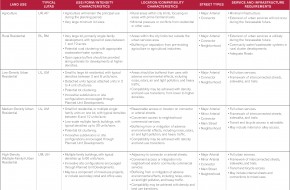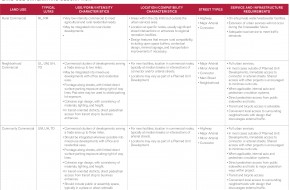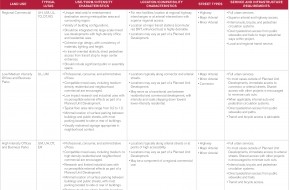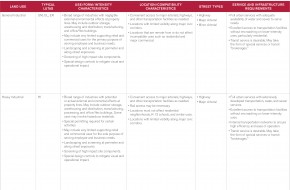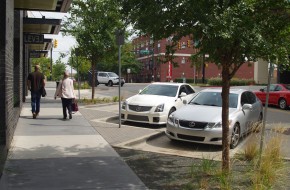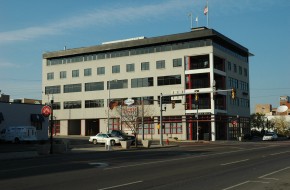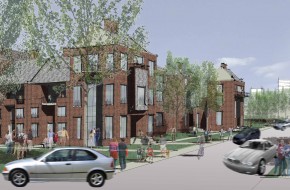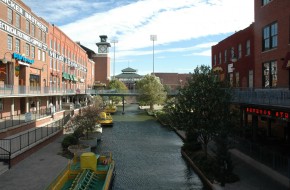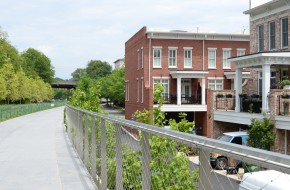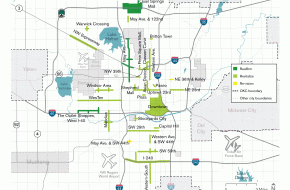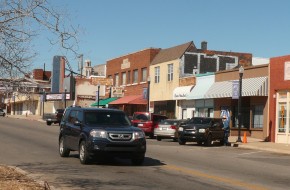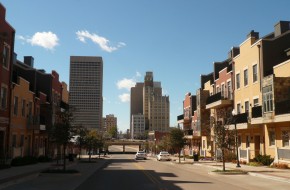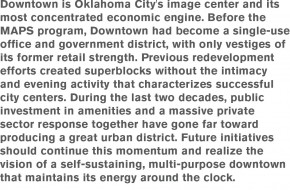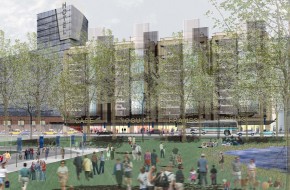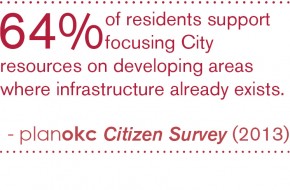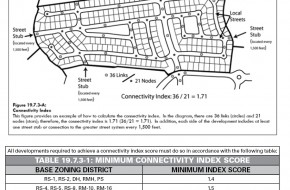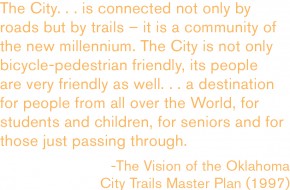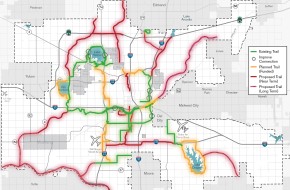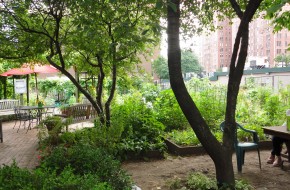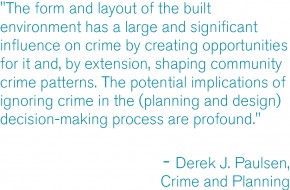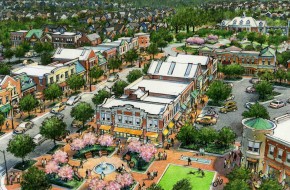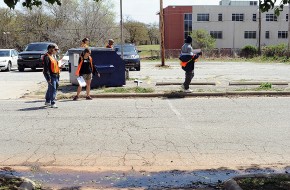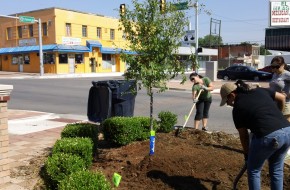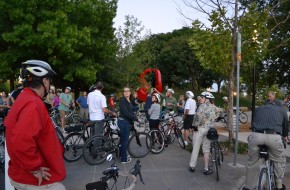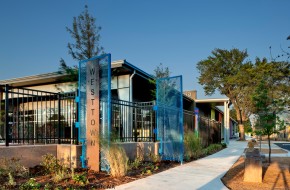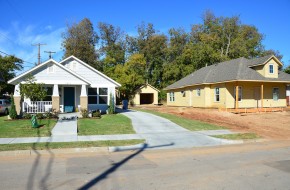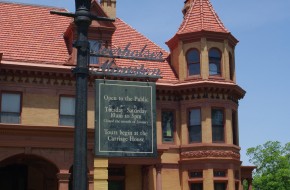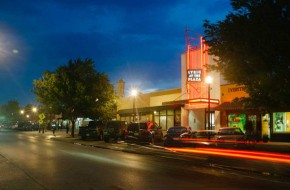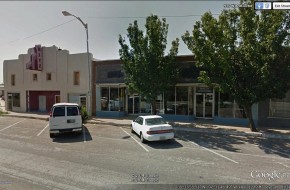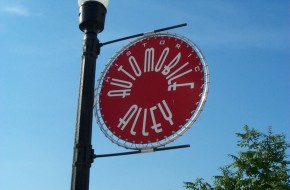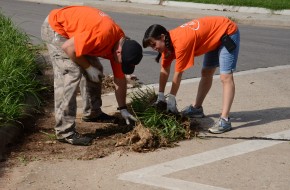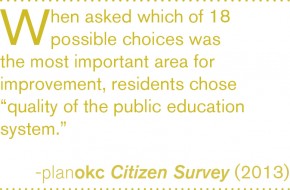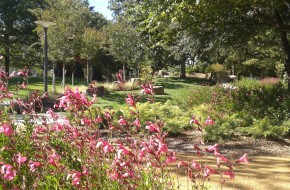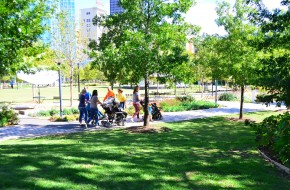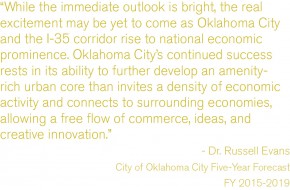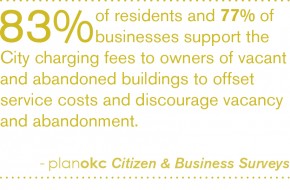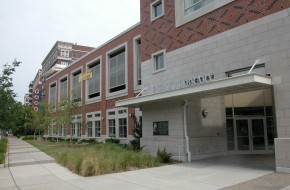The initiatives below relate to housing. Click on any initiative to view a full explanation and related policies.
We will ensure that land uses are located on sites that meet their needs, work cohesively in their environments, and are served by appropriate transportation and infrastructure. While the LUTA concept encourages integration of uses, it does not suggest that any land use is appropriate anywhere. Commercial and industrial uses have particular needs for transportation, surrounding conditions, utilities, and visibility. Urban uses in general require water, wastewater, urban streets, and other infrastructure that can meet their demands for service. These individual requirements apply even in mixed-use environments. This makes specific criteria for location and design of individual uses especially important. Developers and builders will use these criteria as they select sites and design projects. Neighborhood residents will be reassured that potentially incompatible uses will be directed to appropriate sites. Approving groups will use criteria to evaluate the quality of development proposals and their compliance with the comprehensive plan. The tables shown on the right present a base for location and development criteria that should be refined and incorporated into new land use ordinances.
We will revise regulations to better protect residential uses from the negative effects of nearby non-residential uses. Traditional development ordinances attempt to shield residential uses from undesirable effects of adjacent uses by separation. Similar development types do tend to cluster together and keeping different uses apart sometimes works. However, use separation by itself produces inefficient and uninteresting development and often is not viewed as providing reliable protection. For example, Oklahoma City frequently uses Planned Unit Developments to control the details of conventional projects. However, the intention of PUDs was to provide flexibility for innovative development rather than inflexible controls on individual sites. Oklahoma City's new directions in land use planning and regulation instead will create standards and guidelines by which different uses reinforce rather than harm each other.
Certain uses are incompatible and cannot easily be neighbors. The land use system should retain some primary use categories for these situations. But in most cases, transitional standards that encourage mixed-use development and directly control potential incompatibilities should create a more efficient and vital city.
Click to expand policy information.
Coordinate the design, development, expansion, and/or investment in transportation projects with the Land Use Typology map.
Require traffic impact analyses with all comprehensive plan amendments requests to change to a higher intensity LUTA.
Revise Subdivision Regulations and development standards to reflect the street typology standards.
Seek opportunities to co-locate new public projects, such as libraries, fire stations, parks, and recreation centers near compatible civic uses such as schools and campuses to create nodes of activity and services.
Ensure that new publicly financed developments – those which directly use or receive public dollars – with more than 100 units or with densities greater than 10 units/acre are located where they have easy access to frequent transit service.
Modify codes to allow residential clustering in rural land use typology areas, provided water supply and sewage disposal requirements are met, and permanently preserve nearby open space through means such as conservation easements.
Coordinate planning efforts with school districts to attempt concurrent land purchases for schools and parks.
Ensure all homes are within walking distance of a park based on level of service standards for each urban land use typology by updating codes and regulations for new construction and by improving connections and access between existing parks and neighborhoods.
Establish procedures for creating new joint school/park sites, including the division of maintenance responsibilities.
Prioritize capital improvement to construct linkages and connections from the existing urban parks and open space system to neighborhoods, commercial areas, employment centers, and community facilities.
Form a working partnership with the library system, both the Metropolitan Library System and the Oklahoma Department of Libraries, to coordinate timing of facility expansions, improvements, and new facility siting with other types of civic resources, such as schools, fire stations, parks, and projected growth and demand for those resources. This should also include identifying a mechanism to provide library services in Canadian County.
Provide adequate infrastructure for new or expanding companies by giving priority to Capital Improvements in ER areas. Additionally, consider the implementation of impact fees for infrastructure in order to provide infrastructure in a timely manner and to better coordinate with private development.
Encourage the use of special service districts with enhanced levels of service.
Mitigate negative impacts of compactness by:
- Updating nuisance code to better address noise, smell, vibration, property maintenance, panhandling, animal control, delivery hours limits, and other possible negative effects.
- Updating the sign ordinance to reduce visual clutter.
Prioritize and concentrate development where facilities, infrastructure, and services have capacity and in areas where the Police and Fire Departments are best able to respond. Guide the location and timing of development through the proactive and strategic installation of infrastructure.
Encourage the integration of different land uses in urban areas through the following means:
- Promote the use of performance standards in place of existing zoning methods (which address incompatibility by separating uses). Performance-based regulations should focus on achieving compatibility between uses by addressing the following:
- Noise, odors and air quality
- Traffic and parking (allow flexible, but sufficient parking)
- Site layout and building design
- Waste
- Safety
- Lighting (glare control, placement, and shielding)
- Delivery hours
- Enhance transit service (bus and rail).
- Prevent large areas of concentration of any particular land use such as multi-family or commercial.
Higher density multifamily development should be located in areas near employment or educational centers where street and transit systems have, or will soon have capacity to support the added trips.
Avoid concentrations of apartment complexes. Instead, integrate multifamily units into neighborhoods with mixes of housing types or in mixed-use developments.
We will provide incentives and investments that produce a favorable environment for private investment on underutilized sites. In Oklahoma City, we have tended to view land as an inexhaustible and disposable resource, reducing the desirability of older areas and decreasing land values, while expanding the city's boundaries outward. The surveys and process of planokc show that this view is also changing, as citizens place a high value on using existing infrastructure and urban land effectively and rebuilding established neighborhoods. Preferences are also changing, as many families appreciate active urban places like Midtown and Automobile Alley that provide living, shopping, entertainment, and work places with good walking, bike, and transit access. Effective use of existing land resources is a central principle of Chapter Two's land use vision.
Redevelopment and infill depend on major private investment. City policy and action can create the conditions that help this private investment occur.
Directions for these policies include:
- Site assembly. Multiple property owners, often absent or very difficult to find, can make it impossible to put together sites for redevelopment. The City can help private developers by helping them assemble sites.
- Infrastructure and street improvement. While redevelopment and infill sites usually have infrastructure, these facilities are sometime obsolete and require improvement. Redevelopment can provide the impetus for making necessary public investments in these assets.
- Public investments. Parks, schools, civic facilities, pedestrian and bicycle facilities, streetscapes, and other amenities can provide anchors that are proven to generate private development. The Bricktown Canal is an excellent example of a public amenity that has paid for itself many times over in private investment. Similarly, the new MAPS 3 Park will inevitably become the catalyst for the Core to Shore redevelopment.
- Code improvement and proactive enforcement. Poor property maintenance, unattractive and cluttered signs, and public or operating nuisances can degrade the value of surrounding property and discourage reinvestment. Updated ordinances and consistent, enforcement will minimize these disincentives and create momentum for new private development.
Click to expand policy information.
Establish new incentives and raise awareness of existing incentives that stimulate the preservation and rehabilitation of historic resources. Incentives could include:
- Preservation easements, low-interest or forgivable rehabilitation loans, and Tax Increment Financing Districts for historic buildings, sites, and districts.
- Tools and practices for public/private partnerships to ensure the preservation and retention of top-priority historic resources whose deterioration or demolition would present an irreparable and highly significant loss to the City and beyond.
- Existing city, state, and federal tools and incentives for rehabilitation, including state and federal tax credits for certified rehabilitation.
- Expedited review process for projects involving infill sites.
Support and incentivize the adaptive use of existing buildings, infill development, and brownfield development.
Modify codes and/or regulations to create opportunities for more income diversity and mixed-income neighborhoods by allowing a variety of housing ownership and leasing arrangements, diverse housing sizes and types – including accessory dwelling units, carriage homes, lofts, live-work spaces, cottages, and manufactured/modular housing. Modifications should allow an increase the variety of ownership opportunities to include condominiums, ownership cooperatives (such as mutual housing associations, limited equity cooperatives, etc.) by identifying and removing regulatory barriers. Recommend improvements to protections for owners, developers, and lenders.
Priority should be given to projects that achieve efficiencies described elsewhere in planokc, such as dwelling units that are located to have easy access to each other and to other daily needs including jobs, recreation, and schools.
Maximize the use of all appropriate state, federal, local, and private funding for the development, preservation, and rehabilitation of housing affordable to a variety of income groups, including those that integrate low-income housing units in otherwise market-rate housing developments and support the creation and/or expansion of mixed-income communities.
Integrate housing rehabilitation programs with neighborhood revitalization programs. These programs should include assistance to property owners to renovate the existing housing stock with improvements that reduce utility and maintenance costs for owners and occupants, conserve energy, conserve water, and reduce greenhouse gas emissions.
Establish new or expand existing financing methods and/or mechanisms available to new and redevelopment mixed-income projects in urban areas. These could include: direct investment of public housing funds, tax-increment financing, bonds, revolving loans, housing program funds and/or other proven public-private partnership models.
Create and/or enhance Community Development Corporations (CDCs) and Community Housing Development Organizations (CHDOs) to increase their capacity to provide mixed-income housing, especially in targeted infill areas.
Reuse brownfield, greyfield, and other vacant building sites to provide new opportunities for mixed-used and mixed-income housing.
Prevent concentration of low-income populations by providing housing opportunities for all income groups in targeted redevelopment areas of the city with a particular focus on mixed-income projects, especially on those projects that have a public funding component.
In conjunction with City regulatory changes, such as significant modifications to zoning ordinances, building codes, or subdivision regulations, assess the effects of the proposed modifications on housing development costs and overall housing affordability, considering the balance between housing affordability and other objectives such as environmental quality, urban design quality, maintenance of neighborhood character and protection of public health, safety and welfare. This assessment should be integrated into the code amendment process, identify barriers to housing affordability, and include recommended mitigation.
Add legislative priorities for state laws to:
- Strengthen the City’s ability to obtain specific performance of property owners cited for code violations.
- Speed up the demolition process for long-time boarded properties that cannot be rehabilitated.
- Strengthen the City’s ability to require property owners to rehabilitate or sell neglected, boarded-up properties.
- Expedite the clearing of properties involved in probate.
Strategically use subsidized housing programs along with other City services and programs to revitalize targeted areas of the city.
Support infill development on vacant, underutilized, and brownfield sites by:
- Allowing densities sufficient to incentivize infill in older areas
- Focusing resources on target neighborhoods to build positive momentum
- Evaluating and adjusting zoning in areas where infill is desired
- Reducing permit fees and processing time for infill development proposals
- Waiving the requirement for traffic impact analyses for infill development proposals
- Establishing an Abandoned Buildings Program and enhancing it over time by:
- Seeking changes in City ordinance and State statute where necessary to allow for cost recovery of police and fire services costs caused by vacant buildings
- Using revenue collected beyond Vacant and Abandoned Buildings program administration cost for neighborhood improvements
- Submitting land bank legislation to the State Legislature and establishing a land bank authorized to acquire, rehabilitate, and dispose of abandoned properties
- Offering temporary or short term catalyzing incentives for the first “infillers” in target neighborhoods. Incentives may include small grants and/or low interest loans from a revolving loan fund or for property improvements.
- Evaluating the possibility of basing property taxes on only land value and not improvements, thereby encouraging high intensity use of well-positioned land and discouraging underutilization and long–term vacancy.
Mitigate negative impacts of compactness by:
- Updating nuisance code to better address noise, smell, vibration, property maintenance, panhandling, animal control, delivery hours limits, and other possible negative effects.
- Updating the sign ordinance to reduce visual clutter.
Prioritize and concentrate development where facilities, infrastructure, and services have capacity and in areas where the Police and Fire Departments are best able to respond. Guide the location and timing of development through the proactive and strategic installation of infrastructure.
Create and implement small area plans for neighborhoods or districts with special strategic importance or complications related to development or redevelopment.
Identify priority areas where the City can maximize private investment by providing public infrastructure and amenities including:
- Transit;
- Parks, trails, sidewalks;
- Streets;
- Arts and cultural facilities.
Encourage redevelopment and infill development on vacant, underutilized, and brownfield sites in urbanized areas.
Catalyze infill development on vacant, underutilized, and brownfield sites in urbanized areas by:
- Investing in infrastructure improvements;
- Improving multi-modal transportation networks;
- Improving parks and open spaces;
- Improving schools and other civic resources;
- Exploring innovative methods such as:
- A public-private partnership to purchase problem properties in target areas and build or rehabilitate homes while improving infrastructure and amenities
- An infill house plan program similar to Sacramento or Milwaukee
- Identifying and removing barriers to rehabilitation and/or replacement of residential buildings.
- Establishing a position in the City to facilitate medium- and large-scale redevelopment projects through the development process by guiding interactions with City departments, allied agencies, and utility companies.
Encourage the adaptive reuse of underutilized structures and the revitalization of older, economically distressed neighborhoods.
We will build housing and neighborhoods that address the needs of citizens at all stages of their lives. Oklahoma City's citizens and their households have characteristics such as family size, income, age, and tastes that require diverse housing choices. In the past, the majority of new housing development has been single-family, detached, and owner-occupied on relatively large lots. We have also tended to separate housing by type and cost, encouraged by our zoning and subdivision ordinances. However, the private market and resident needs are moving toward greater diversification – different designs, densities, and prices, connected together into neighborhoods. Most housing is built privately, and builders, who respond to markets, cannot be forced to build certain kinds of products. City decisions should encourage both diversity and integration of housing types to the maximum degree possible. Implementing the LUTA concept will help remove statutory obstacles to projects that include diverse housing types and relate them to each other. Updated subdivision regulations will also require the street, pedestrian, and bicycle connectivity, common space, and housing variety needed to turn "pods" into communities.
Design standards can establish a baseline for quality development that respects the needs for both privacy and civic life, and incentives should reward builders and developers who innovate to build diverse, active communities.
Click to expand policy information.
Maximize the use of all appropriate state, federal, local, and private funding for the development, preservation, and rehabilitation of housing affordable to a variety of income groups, including those that integrate low-income housing units in otherwise market-rate housing developments and support the creation and/or expansion of mixed-income communities.
Integrate housing rehabilitation programs with neighborhood revitalization programs. These programs should include assistance to property owners to renovate the existing housing stock with improvements that reduce utility and maintenance costs for owners and occupants, conserve energy, conserve water, and reduce greenhouse gas emissions.
Create and/or enhance Community Development Corporations (CDCs) and Community Housing Development Organizations (CHDOs) to increase their capacity to provide mixed-income housing, especially in targeted infill areas.
Prevent concentration of low-income populations by providing housing opportunities for all income groups in targeted redevelopment areas of the city with a particular focus on mixed-income projects, especially on those projects that have a public funding component.
Create regulations/standards/guidelines that focus on design and/or compatibility principles which are sensitive to the surrounding urban form, especially in areas that are stable or improving and whose character is well-established. These provisions should also help ensure compatibility between lower- and higher- intensity land uses.
In conjunction with City regulatory changes, such as significant modifications to zoning ordinances, building codes, or subdivision regulations, assess the effects of the proposed modifications on housing development costs and overall housing affordability, considering the balance between housing affordability and other objectives such as environmental quality, urban design quality, maintenance of neighborhood character and protection of public health, safety and welfare. This assessment should be integrated into the code amendment process, identify barriers to housing affordability, and include recommended mitigation.
Increase the viability of townhomes and condominiums as housing products by:
- Adopting and supporting new local and state laws to increase consumer protection for condos and townhomes (e.g., better funding mechanisms and maintenance enforcement for common areas).
- Requiring developers to demonstrate sustainable funding levels for common area and facility maintenance costs.
Support diversity and integration of housing unit types and sizes in all land use typology areas in order to meet the diverse needs of households of different sizes, generational needs, incomes, and preferences. New residential subdivisions should achieve a mixture of housing types within a unified development.
Avoid concentrations of apartment complexes. Instead, integrate multifamily units into neighborhoods with mixes of housing types or in mixed-use developments.
Amend the zoning ordinance to better accommodate the integration of various residential densities, building types, and styles.
Create design standards and guidelines for the design, materials, shared amenities, and accessibility of high density urban residential development. Standards and guidelines should promote privacy and livability in a high density, mixed-use environment.
Evaluate existing regulations for effectiveness in promoting density and mixed-use development and in addressing surface parking. Develop a new urban design code for downtown and other key districts to promote healthy mixes of land uses that are compatible and complementary.
Adopt subdivision regulations that ensure new neighborhoods meet the basic needs of residents while supporting an efficient development pattern. Regulations should cover:
- Open space (passive and active),
- Demonstration of sustainable funding levels for common area and facility maintenance costs,
- Walkability and bikeability,
- Internal and external street connectivity,
- Block length,
- Integration of uses,
- Integration of a variety of home sizes,
- Integration of a variety of unit types, and
- Preservation of Environmentally Sensitive Areas.
Regulations could be based on a point scale to allow flexibility, while still requiring basic minimum thresholds be met.
New regulations should remove the existing requirement for development in Rural LUTAs to connect to water and sewer systems and establish a minimum one-acre lot size for lots with on-site sewer treatment.
We will place a priority on increasing the economic strength and growth of viable existing commercial nodes and corridors. Commercial development typically flees to the "next new thing," leaving previous locations for new sites, usually in growth areas. While understandable, this trend leaves older commercial areas underutilized with more marginal businesses and vacancy, lower rents, and reduced upkeep and investment. While market conditions and age will inevitably make some areas less competitive, we must maintain the strength of our existing viable districts. This program may include:
- Improving the function and convenience of commercial areas with improved transportation access, including better local circulation, enhanced transit service, and internal and external pedestrian and bicycle linkages.
- Creating a better physical environment through streetscape and public space investments.
- Providing financial incentives like tax increment financing for site and building upgrades, and for introduction of new uses into single-use commercial areas.
- Creating new parking standards for mixed-use projects that recognize that different uses generate their highest parking demands at different times.
- Encouraging new commercial within redevelopment areas, benefitting existing retailing by introducing new nearby attractions.
We will implement strategies for the reuse and redevelopment of low-performing commercial areas. Cities don't stand still and neither do retail markets. Some of the city's commercial areas are no longer viable in their current form, but still siphon some commercial activity from other, stronger districts. We will implement strategies for revitalization of these underutilized but still important districts.
Click to expand policy information.
Create and implement small area plans for neighborhoods or districts with special strategic importance or complications related to development or redevelopment.
Prioritize maintaining the strength of existing commercial nodes and corridors over providing new areas for commercial development.
Continue promoting the re-use, redevelopment, and revitalization of low-performing or declining commercial areas.
Incentives for new regional retail development should only be considered if the proposed project truly creates a new regional destination for the city and does not significantly cannibalize sales from existing Regional Districts.
Regional-, community-, and neighborhood-scale retail developments should provide an internal vehicle and pedestrian circulation system between new and existing centers and individual stores that draws on the following principles:
- Concentrate access for new retail development at shared primary entrance points. Primary entrance points should be aligned with access points immediately across intersecting roads. Limit curb cuts on primary highways and arterials.
- Provide pedestrian circulation, including sidewalks and median breaks along interior and exterior fronting roads and within parking lots.
- Encourage coordinated development of retail centers in order to facilitate internal pedestrian and vehicle circulation and optimal center performance.
Wayfinding mechanisms and other placemaking features should be strongly encouraged in new and existing commercial districts.
We will continue the process of creating a mixed-use, intensively developed, human-scaled, and experience-rich downtown. American downtowns declined as the number of reasons that brought people downtown decreased. Recently, downtowns have achieved success as places to live and visit as well as work. This evolution in Oklahoma City began in Bricktown and surrounding areas, where the canal and ballpark anchored adaptive reuse of historic buildings and the addition of new restaurants, entertainment venues, hotels, offices, and homes. This transformation continued with the addition of one of the National Basketball Association's premier franchises, the Civic Center restoration, major office projects, and new housing. While the growth and development of downtown will always be ongoing, these accomplishments provide the foundation for building a great 21st century downtown.
Land use and development targets and policies will be instrumental in guiding this future. Major land use focuses will include a range of housing types and costs to serve a complete cross-section of the Oklahoma City market; services and retailing that support a larger resident population, including child care, educational facilities, and neighborhood commercial uses like a grocery store; integration of multiple uses into new and existing buildings; and public parks and open spaces for both programmed and informal activity. Much of this future development will occur on currently under-used sites such as the Core to Shore redevelopment area, the future Boulevard on the former I-40 right-of-way; existing surface parking lots, and vacant sites. Initial steps in meeting these needs include revisions of regulations to accelerate desirable uses and market research to demonstrate and quantify markets for specific project types.
As Downtown continues to develop, it must also evolve as a great urban place that offers a superb experience to its residents, workers, and visitors. The history of the urban renewal era in Oklahoma City tells us that investment dollars and big projects alone do not create a living and vibrant city center. A secure, populated, human-scaled environment requires family-friendly amenities, windows on the street, buildings with details scaled to people, pedestrian environments that engage the eye and mind, and an overall sense of welcoming and even festivity. These features have the power to attract the life that is characteristic of great downtowns.
Click to expand policy information.
Promote the downtown area as an attractive place to live and play for all household types, including families with children by:
- Requiring human scale site and building designs
- Focusing on pedestrian friendliness
- Adding family-friendly public amenities including parks, open space, greenways, plazas, bikeways, public art, etc.
- Limiting noise and protecting privacy
- Ensuring new buildings and sites are designed to be attractive and to enhance safety and the sense of safety.
- Encouraging employment and residential uses in close proximity
- Encouraging or requiring a percentage of condominium or apartment units to be 2 and 3 bedroom units
- Encouraging “child-friendly” development near schools and discouraging uses that could be detrimental to schools’ viability
- Instituting on-street police officers on foot or bicycle to maintain “eyes on the street” and enhance public safety and security
Attract and retain young professionals to downtown and its environs to support and enhance place-making efforts and investments.
- Explore the possibility of the Greater Oklahoma City Chamber of Commerce contracting with the City to facilitate and promote civic engagement and social opportunities for young professionals.
Facilitate the development of housing in the Downtown, Bricktown, and Core to Shore areas in order to increase activity levels and demand for retail and amenities.
Strengthen downtown’s sense of place and activity levels by encouraging more housing, retail, public plazas, public art, parks, indoor recreation facilities, and arts and cultural facilities.
Increase land use diversity in Bricktown to attract and retain visitors and development momentum. Specifically, encourage more retail, office, and recreational uses rather than additional bars and restaurants, so that visitors of all ages and interests will be motivated to visit and stay longer.
In order to promote compatibility between different uses, establish standards and guidelines that ensure all developments are pedestrian-friendly and human scale at street frontages and property lines.
Enhance Downtown Oklahoma City’s prominence by maintaining and increasing its role as the major business center, establishing it as a major urban residential center, and focusing on developing retail, office, entertainment, and arts and cultural uses.
Continue to pursue a full scale downtown grocery store or a natural food grocer by:
- Increasing the amount of downtown housing
- Conducting a market study to quantify existing and future potential
- Promoting downtown to potential store operators
- Providing incentives such as land, infrastructure, or sales tax rebates, and allowing for mixed-use (vertical) integration with other uses including, but not limited to, residential.
Encourage development of new educational and childcare facilities downtown to accommodate families with children that work and/or live downtown.
In Downtown and adjacent areas, encourage the development of affordable housing for moderate-income households through incentives or requirements such as:
- Requiring a percentage of units in all new apartment and condominium developments to be affordable to working households with incomes of 80 to 100 percent of the area median family income as defined by the U.S. Department of Housing and Urban Development. Developments may be exempted through payment of an in-lieu fee to go towards development of affordable housing.
- Establishing a density bonus program where appropriate.
- Establishing financial incentives for development of affordable housing.
Evaluate existing regulations for effectiveness in promoting density and mixed-use development and in addressing surface parking. Develop a new urban design code for downtown and other key districts to promote healthy mixes of land uses that are compatible and complementary.
We will implement the Core to Shore redevelopment plan. Core to Shore, linking Downtown with the Oklahoma Riverfront, is an exceedingly important project for many reasons. Its 800 acres will develop a completely new, mixed income residential neighborhood that can add up to 10,000 people to the immediate Downtown market. The MAPS 3 Downtown Upper and Lower Parks, other green spaces, and the SkyDance bridge will provide open space and recreation for the entire downtown community and will unite the riverfront greenway and the city center. Finally, the boulevard, convention center, and associated development will heal a barrier that has long divided downtown from its surrounding neighborhoods. Other cities such as Chicago with the redevelopment of the South Loop have demonstrated the dramatic impact of district-wide redevelopment adjacent to a major downtown. Core to Shore is that kind of historic project for Oklahoma City.
Click to expand policy information.
Support infill development on vacant, underutilized, and brownfield sites by:
- Allowing densities sufficient to incentivize infill in older areas
- Focusing resources on target neighborhoods to build positive momentum
- Evaluating and adjusting zoning in areas where infill is desired
- Reducing permit fees and processing time for infill development proposals
- Waiving the requirement for traffic impact analyses for infill development proposals
- Establishing an Abandoned Buildings Program and enhancing it over time by:
- Seeking changes in City ordinance and State statute where necessary to allow for cost recovery of police and fire services costs caused by vacant buildings
- Using revenue collected beyond Vacant and Abandoned Buildings program administration cost for neighborhood improvements
- Submitting land bank legislation to the State Legislature and establishing a land bank authorized to acquire, rehabilitate, and dispose of abandoned properties
- Offering temporary or short term catalyzing incentives for the first “infillers” in target neighborhoods. Incentives may include small grants and/or low interest loans from a revolving loan fund or for property improvements.
- Evaluating the possibility of basing property taxes on only land value and not improvements, thereby encouraging high intensity use of well-positioned land and discouraging underutilization and long–term vacancy.
Enhance Downtown Oklahoma City’s prominence by maintaining and increasing its role as the major business center, establishing it as a major urban residential center, and focusing on developing retail, office, entertainment, and arts and cultural uses.
Work to establish a critical mass of retail uses in the downtown area. A lifestyle center or mixed-use town center presents the most viable option for a major infusion of retail into downtown.
Evaluate existing regulations for effectiveness in promoting density and mixed-use development and in addressing surface parking. Develop a new urban design code for downtown and other key districts to promote healthy mixes of land uses that are compatible and complementary.
We will preserve rural character and grow efficiently by managing the growth of urban development. Without careful phasing of infrastructure extensions and development in new areas, we will continue to use existing infrastructure inefficiently while incurring the higher costs of extending facilities prematurely; create land use conflicts with existing farms; and change the character of land for people who built homes or made other investments based on rural character.
Urban growth will occur in many areas, but these new growth areas should receive infrastructure as the market demands, with incremental utility extensions contiguous to pre-existing urban development. This will require designing and implementing an infrastructure management system, possibly establishing sub-watershed districts which would be opened to development as required by land availability or economic considerations. New basins would be opened to development when existing areas with full services reach a certain percentage of development. In the meantime, areas that can feasibly receive urban infrastructure in the future should be reserved for urban development through the Urban Reserve LUTA.
Infrastructure financing techniques should recognize both the need to manage and direct the geographic extent of development, and the need for partnerships between the public and private sectors to extend services and utilities. For example, the City could provide front-end financing for infrastructure in a specific growth area, reimbursed or offset by impact fees and special service district assessments calculated on the basis of the yield of the area.
We will reinforce the character and quality of existing rural development and provide the ability for some very large lot development in some areas which are unlikely to receive infrastructure in the short term. Oklahoma City has a substantial amount of rural residential development within its city limits. The integrity and rural character of this development should be respected as previous investments in infrastructure are efficiently used. These rural areas also have a significant population that requires convenience and commercial services. Land use policies will provide for limited commercial development to address these specific service needs. The Rural LUTAs specifically recognize that maintaining character, using infrastructure efficiently, and providing supporting commercial are priorities.
While we can plan for sound, gradual expansion of the city through the Urban Reserve LUTA, we should provide existing landowners with the opportunity to realize a reasonable development return on their land. We will consider innovative techniques like Build-Through Acreages, allowing rural density development on a portion of a parcel with adoption of an overall master plan that achieves urban densities when utilities are extended.
Click to expand policy information.
Revise subdivision regulations to include connectivity standards and guidelines that require greater street connectivity, and provide allowances for pedestrian and bicycle connections when street connectivity cannot be made.
Establish access management requirements that limit driveways on arterials and collectors and increase connections between uses to improve safety and traffic efficiency.
Change subdivision regulations to determine the number of entries into a residential development based on number of lots in order to improve connectivity of the roadway network and emergency response.
In order to accommodate desires for large-lot development in Urban Reserve areas, implement innovative techniques such as build-through acreages (otherwise known as shadow platting or ghost platting) that permit interim large-lot development of a site or a portion of a site with a master plan that achieves an overall future density target for urban development.
Prioritize and concentrate development where facilities, infrastructure, and services have capacity and in areas where the Police and Fire Departments are best able to respond. Guide the location and timing of development through the proactive and strategic installation of infrastructure.
Use one or more of the following methods to ensure infrastructure and facility capacities are adequate for proposed development:
- Ongoing master planning to determine the necessary water, sewer, and road infrastructure to serve development.
- An impact fee system that collects funds for specific areas as they develop and installs needed infrastructure in a timely manner.
- Use of special service districts to ensure appropriate levels of service, sufficient revenue, and timely installation of infrastructure and facilities for each district.
- Require developers to construct or fully fund infrastructure or other improvements needed to serve their development, with reasonable accommodation for future adjacent or nearby development.
- Require developers to wait until the City (or the State as the case may be) constructs the infrastructure needed to serve their development.
- For development proposed in areas not currently within one-half mile of existing water infrastructure, require a service area study to first be completed to determine the best method for providing water to the service area.
For development proposed in areas not currently within a sanitary sewer drainage basin, a drainage basin study should first be completed to determine the best method for sanitary sewer service.
Preserve existing rural residential character while pursuing optimal use of existing infrastructure in rural areas.
Ensure that development in rural areas is consistent with local design and scale and does not detract from the open character of the landscape.
Support limited amounts of commercial in rural areas appropriate to the needs of rural residents and passersby. Commercial uses in rural areas should be located in small clusters either on uninterrupted arterials or at freeway interchanges.
Adopt subdivision regulations that ensure new neighborhoods meet the basic needs of residents while supporting an efficient development pattern. Regulations should cover:
- Open space (passive and active),
- Demonstration of sustainable funding levels for common area and facility maintenance costs,
- Walkability and bikeability,
- Internal and external street connectivity,
- Block length,
- Integration of uses,
- Integration of a variety of home sizes,
- Integration of a variety of unit types, and
- Preservation of Environmentally Sensitive Areas.
Regulations could be based on a point scale to allow flexibility, while still requiring basic minimum thresholds be met.
New regulations should remove the existing requirement for development in Rural LUTAs to connect to water and sewer systems and establish a minimum one-acre lot size for lots with on-site sewer treatment.
We will provide good street connections within and between neighborhoods to provide a choice of routes and separate local traffic from major arterials. Good street connectivity has many benefits. By providing alternative routes for short distance trips, it indirectly increases the capacity of arterial streets. It also provides better quiet street opportunities for pedestrians and bicyclists, and improves the efficiency of delivering emergency access and city services.
Click to expand policy information.
Maintain the traditional grid street pattern where it currently exists, reconnect it where possible, and keep alleys open and functioning. When improving older streets in neighborhoods, maintain original street widths and curb radii.
Improve the functionality and efficiency of the street network by:
- Providing direct connections from residential developments to nearby places and to each other.
- Providing street and sidewalk stubs to adjacent vacant land in anticipation of future development.
- Connecting new development to existing street and sidewalk stubs, and to existing trail, open space, and bicycle networks.
- Reducing block sizes and use of dead-end streets.
- Maintaining the existing street grid to preserve connectivity and mobility options.
Revise subdivision regulations to include connectivity standards and guidelines that require greater street connectivity, and provide allowances for pedestrian and bicycle connections when street connectivity cannot be made.
Change subdivision regulations to determine the number of entries into a residential development based on number of lots in order to improve connectivity of the roadway network and emergency response.
Maintain existing alleys or construct new alleys where feasible to provide trash collection service and parking behind primary buildings and minimize curb cuts along the primary street frontage.
Target specific areas of the city for enhanced safety and proactive enforcement. Selection of target areas will be informed by the Intelligence Led Policing program, with coordinated involvement from Police, Code Enforcement, Public Works Department, Planning, and community-based organizations.
Evaluate development proposals to assess design components that contribute to or detract from safety and analyze emergency response capacity and capability.
We will establish a systematic neighborhood street program, focused on rehabilitation, traffic calming, and safety and functional improvements. Citizens place a high priority on the condition and repair of the existing street system. The streets that affect residents most – local and connector streets – are rarely addressed by normal transportation programs. A systematic neighborhood street program will both provide regular funding for street repair and rehabilitation and completion of special street projects such as traffic calming.
Click to expand policy information.
Establish a process for existing neighborhoods to request traffic calming, including how to evaluate the request, select the appropriate type of calming treatment, and fund recommendations.
Improve parking provisions in neighborhoods that are near vibrant commercial corridors/areas by improving parking and corridor design, non-vehicular networks, transit, and signage.
Incorporate preventive health care and wellness education into public schools, recreation centers, senior centers, and technical/trade schools.
Evaluate development proposals to assess design components that contribute to or detract from safety and analyze emergency response capacity and capability.
We will design or retrofit trails to provide convenient and barrier-free access to adjacent streets and major destinations. A trail that provides miles but does not connect to its surroundings may provide benefits to people seeking workouts, but it fails in its transportation mission to move people to places. In addition, poor access or visibility to and from surroundings can create public safety problems as well. We must design new trails and retrofit existing trails to provide frequent and comfortable access to wayside destinations and streets, with clear signage that helps orient users to their location.
Click to expand policy information.
Create a standards for trails based on industry standards, “Crime Prevention Through Environmental Design” principles, expected use, and surrounding land uses.
Acquire easements in new and existing developments to develop and connect trails.
Establish connections between parks, residential areas, and other points of interest by constructing additional bike routes, trails and pedestrian paths to meet the growing demands for recreation and alternative transportation routes.
Require that new development tie into the park and trail system by providing linkages to existing parks or dedicating new park land. Connect existing parks and neighborhoods to create a continuous system of open spaces, for example along stream corridors.
We will establish clear private and public funding mechanisms for sidewalk construction and repair, and define and enforce maintenance responsibilities for property owners. Several issues complicate funding and maintenance requirements. First, sidewalks are a community responsibility at both citywide and local levels – failure to comply with requirements by one or two property owners can deprive many people of access. Second, in many cases, people with the least ability to build, repair, or maintain sidewalks have the greatest need for them. Third, funding for sidewalks has often been collected through special assessments, often leading to opposition from adjacent property owners. We must develop alternatives that encourage sidewalk connectivity and maintenance. Neighborhoods may be more engaged in sidewalk development or maintenance when owners are unable to meet these responsibilities, and sidewalk networks in local areas may require some level of public funding to be developed fully.
Click to expand policy information.
Enhance the safety and walkability of the sidewalk network through:
- Establishing a citywide bicycle and pedestrian master plan that includes an inventory of sidewalk locations and conditions, and priorities for enhancement.
- Implementing sidewalk improvements through future bond issues, CIP projects or other sources of funding as prioritized in the citywide bicycle and pedestrian master plan.
- Maintaining currency of the citywide bicycle and pedestrian master plan.
- Explore the feasibility of the City assuming responsibility for sidewalk maintenance.
Click to expand policy information.
Enhance the City’s Landscape Ordinance by accomplishing the following objectives:
- Add guidelines and recommendations for landscape design that minimizes the need for supplemental irrigation.
- Clarify responsibilities and standards for landscape maintenance, including within public rights-of-way.
- Incentivize the use of drought-tolerant and native plants.
- Restrict the use of turf grass to the greatest extent feasible.
- Evaluate existing landscape standards for parking lots and consider making revisions that would result in more landscape buffering on parking lot fringes and more internal landscaping.
- Evaluate existing landscape standards to determine whether new standards should be adopted to help screen or buffer parking structures.
- Evaluate existing landscape standards in comparison to best practices and peer cities to determine whether minimum site landscaping standards should be revised and/or restructured to result in increased landscaping.
Pursue grants, partnerships, and programs that accomplish the following:
- Restore tree stands and wildlife habitats in environmentally sensitive areas.
- Acquire land or establish conservation easements in environmentally sensitive areas to reserve as permanent open space and protect wildlife and habitat.
- Establish a comprehensive habitat management program.
- Provide education and resources for proper use of pesticides and fertilizers, with special focus on encouraging integrated pest management and organic practices.
- Provide education about land management practices that address fire suppression, invasive species, use of herbicides/pesticides, and overgrazing.
- Promote the economic and aesthetic value of preserving Oklahoma City’s natural resources such as riparian areas, Cross Timbers forest, grasslands/prairie, bottomland forests, and wetlands.
Support and incentivize the adaptive use of existing buildings, infill development, and brownfield development.
Using performance standards related to flow quantity, quality, and pattern, modify development regulations, codes, and policies to support the use of green infrastructure/low impact development techniques to mimic natural systems for developments within aquifer recharge zones with moderate or high vulnerability or in areas where streams and riparian areas have been channelized or developed (primarily in the Downtown, UH, and UM LUTAs). Low impact development techniques include but are not limited to:
- Onsite treating or filtering of stormwater contaminants.
- Discharging run-off as sheet-flow after passing through grassy or vegetated open space areas, rather than discharging run-off through concentrated outfalls.
- Creating attractive open space amenities that double as stormwater detention, retention, and / or filtering systems.
- Utilizing pervious pavement, pavers, or asphalt in appropriate locations (i.e. sidewalks, parking spaces, trails, patios, etc.).
- Utilizing planters (at grade or raised), vegetated landscape strips adjacent to roads and parking areas, and alternative curbing designs (allowing stormwater to easily move from impervious areas to pervious areas), to encourage stormwater infiltration and temporary detention.
- Rain Gardens
- Bioswales
- Green streets and alleys
- Green roofs
- Rooftop collection
- Underground detention
- Increased tree canopy preservation/tree planting
- Land/open space conservation
- Cluster development
Establish incentives such as a simplified permitting process, reduced application fees, and special recognition for projects that:
- Utilize best management practices or other low-impact development methods for storm water management.
- Bring buried streams to the surface and restore riparian habitat.
- Install bridge systems instead of culverts for stream crossings to help maintain the natural ecosystem associated with the stream.
Develop a comprehensive watershed management strategy that identifies programs, partnerships, actions, and incentives that the City and partners can take to protect the city’s water resources and aquatic areas. The strategy should address the following:
- Creation of a Stormwater Master Plan.
- Update to the City’s sediment control program and establishment of performance measures.
- Coordinated watershed restoration projects.
- Preparation and implementation of Small Watershed Action Plans (SWAPs) and participation in studies to identify needs and opportunities for stream restoration, wetland creation and restoration, and storm water management.
- Identification of opportunities to create wetlands to offset construction and other land development impacts.
- Identification and utilization of “receiving lands” that can absorb storm surge overflows.
- Public education on how to conserve water and minimize chemicals, pathogens, sediment, and nutrients in urban and rural watersheds.
- Acquisition and protection of greenways, river buffers and flood prone areas.
Evaluate the City’s stormwater detention/retention requirements, including the current fee-in-lieu of program, and compare to current best management practices. Based on findings, modify codes, policies and development regulations to update stormwater detention/retention requirements. These requirements should focus on:
- Reducing the risks of property damage due to flooding.
- Managing runoff rates and minimizing stream bank erosion by ensuring that post-development runoff rates do not exceed pre-development rates, even in areas where risks of flooding have historically been low.
- Maintaining surface water quality by managing the release of the first flush stormwater volume in order to encourage settling and filtering of particle and chemical pollutants before releasing water into adjacent water bodies.
Revise development regulations to require the following factors to be addressed in development and redevelopment proposals:
- Preservation of existing natural resources, such as wooded areas, habitat areas, and floodplains.
- Utilization of natural treatments and methods to stabilize or rehabilitate stream and river banks as a means to preserve downstream habitats.
- Integration of a variety of native or compatible non-native, non-invasive plant species.
- Mitigation of impacts of development on habitat, wildlife corridors, riparian and littoral areas, and water quality, through actions such as restoration or re-vegetation of disturbed natural areas and replacement of trees/habitat on-site or off-site.
- Management of invasive plant and animal species.
- Management and maintenance of natural areas, common areas and drainage areas.
- Impact on surface and groundwater supply.
- Impact on water quality caused by land uses and activities.
- Impacts on floodplains, riparian and littoral areas and wetlands and areas with significant landforms.
In areas where standard on-site wastewater systems are not feasible (such as in areas with shallow or poor soils), require very low-density development or development that utilizes conservation design and a centralized treatment facility or other environmentally sensitive systems for wastewater treatment.
Pursue methods to reduce the impact of the urban heat island effect on Oklahoma City by:
- Establishing a minimum canopy coverage requirement over paved surfaces such as parking lots.
- Instating a “continuous canopy” requirement for new streets and street reconstruction projects.
- Promoting the use of building and roofing materials that reduce heat island effects.
Modify development and subdivision regulations, and City policies to minimize alteration of natural landforms and native vegetation and maximize retention of distinctive natural features for public and private projects.
Establish development regulations that help improve air quality, including:
- Specifying construction controls that reduce airborne dust;
- Increasing landscaping and tree planting to absorb carbon dioxide and air pollutants; and
- Encouraging development patterns and densities that support alternative modes of transportation in the urban LUTAs.
Coordinate with local, regional, and State agencies to pursue initiatives and regulations that help reduce automobile emissions, such as:
- Transitioning commercial and City fleets to alternative-fueled and hybrid vehicles;
- Determining the feasibility of an idling restriction ordinance for all vehicles.
Establish strategies, procedures and policies for City construction projects to achieve higher energy efficiency, including:
- Implementing an energy management plan for City facilities.
- Monitoring energy consumption of City facilities, tracking conservation progress, and communicating results to City administrators, employees, elected officials and the public.
- Assessing water use in City facilities to identify opportunities for conservation and implement appropriate measures.
Develop an enforcement mechanism for the City’s Building Energy Code. Develop a healthy building code to support construction of durable, health-promoting and energy efficient buildings that incorporate proven green development practices, locally-sourced and environmentally responsible materials, water conservation fixtures, innovative design and construction techniques, and low waste construction practices. Incentivize their use with shorter approval procedures, priority permits and inspections, and reduced fees.
Partner with agencies, non-profits, and private entities to:
- Implement a sustainable development online forum – an educational and networking resource that will inform the public about local opportunities and the benefits of sustainable development while increasing builder and developer participation.
- Educate citizens on energy and water conservation opportunities both at work and at home.
- Encourage appropriate re-use and reclamation of water in new development and redevelopment to reduce the reliance on potable water use.
- Provide detailed cost-benefit information about green building practices to encourage increased use of such practices in Oklahoma City.
- Reduce reliance on electricity produced by fossil fuel by encouraging the use of renewable energy sources in new development and redevelopment.
- Explore mechanisms (incentives, regulations, programs) to divert demolition debris from landfills and redirect to facilities that can reuse these materials.
- Establish a promotion/award program to showcase innovative development that utilizes low-impact development practices and energy-efficient building techniques / equipment, conserves riparian buffers, and extends greenway networks with hiking/biking trails.
Protect and preserve natural resources, by:
- Identifying and mapping valuable natural resources, such as, native prairies.
- Maintaining a comprehensive inventory and assessment of natural resources and critical habitats.
- Identifying opportunities to create an interconnected green infrastructure network throughout and beyond Oklahoma City’s municipal boundaries via existing trail and greenway projects, parks, stream corridors, and natural areas.
- Seeking the voluntary sale of land or dedication of conservation easements on private land that is identified as critical habitat or is necessary to link wildlife corridors.
- Pursuing protection of strategically identified natural areas by placing them in conservation easements or land banks, and reserving them for future use as open space and passive recreational areas.
- Managing invasive plant and animal species.
- Partnering with applicable State agencies and non-profit entities.
Establish strategies, procedures and policies that prevent degradation or loss of critical habitat and sensitive areas, such as Cross Timbers, upland forests, wetlands, wildlife corridors, groundwater recharge zones, and riparian areas. Protection methods should ensure that placement of lots, alignment of roads, and installation of structures and infrastructure minimize disturbance of the environmentally sensitive areas using tools such as:
- Directing development to appropriate locations;
- Greenbelt preservation;
- Assurance of no development in protected open space;
- Clustering / conservation subdivisions;
- Pervious surface treatments;
- Density transfers; and/or
- Conservation easements.
Ensure that strategies, procedures, and policies incorporate principles of connectivity, minimal fragmentation, representativeness, and heterogeneity.
Replace existing high-maintenance, high-water plant material with attractive native plants.
Adopt design standards to enable emergency management resources to be highly effective, such as resilient buildings, interconnected transportation networks, and other design considerations that help ensure community safety and recovery.
We will enhance policing and crime prevention programs through partnerships between police and local communities. The term "community policing" has become controversial in some instances, but it is in fact a common sense approach to law enforcement that many cities and towns implement without fanfare. Police departments that practice community-based techniques recognize that police alone cannot deal with neighborhood safety and livability issues, but instead must partner with citizens, businesses, organizations, schools, churches, and others to build safe environments.
Community-based programs establish personal relationships and trust between police and residents. Some police departments describe this approach as a "value system" or even "a way of life" as opposed to a program. In Oklahoma City, effective neighborhood policing will involve greater outreach to residents and businesses, interaction with organizations, working relationships with property owners, and other cooperative efforts. A critical support element will involve direct work with at-risk youth and adequate funding for job training, education, and leadership development programs.
Click to expand policy information.
Reverse the detrimental impact of vacant and abandoned buildings through the following efforts:
- Develop an Abandoned Buildings program geared toward a significant reduction in vacancies by creating incentives and/or penalties that discourage prolonged building abandonment and help the City to recoup the costs associated with vacated buildings. Use fees generated by this program to help fund redevelopment of abandoned buildings.
- Assess the feasibility of potential reuse options for dilapidated or abandoned buildings. Define and establish criteria to help identify buildings that are too far gone and/or too costly to feasibly rehabilitate, and consider a coordinated demolition program for those buildings.
- Seek changes in state legislation to enhance the City’s ability to maintain and improve its neighborhoods including:
- Laws which would speed up the demolition process for long-term dilapidated or abandoned properties that cannot be rehabilitated, and
- Laws which would strengthen the City’s ability to require property owners to rehabilitate or sell neglected, boarded-up properties.
Enhance effective policing by:
- Developing and/or enhancing community policing programs, which involve residents and businesses in crime prevention strategies.
- Increasing business presence and participation in community policing.
- Improving public outreach.
- Increasing opportunities for the Oklahoma City Police Department community relations officers to interact with community organizations, neighborhoods groups, schools, recreational and/or athletic programs. This interaction should include increasing resources to allow real-time communication of safety concerns with these organizations.
Seek funding, sponsors, and partnerships to enhance and expand the following crime prevention strategies:
- Education and job training for at-risk youth.
- Community involvement programs such as Light Up The Night, Neighbors Night Out, and other similar activities and programs designed to strengthen neighborhoods.
Target specific areas of the city for enhanced safety and proactive enforcement. Selection of target areas will be informed by the Intelligence Led Policing program, with coordinated involvement from Police, Code Enforcement, Public Works Department, Planning, and community-based organizations.
Create partnerships and programs involving civic groups, business organizations, governmental entities, coalitions, and non-profits to develop or enhance the following:
- School reading programs;
- Elementary school intramural sports leagues;
- Rehabilitation of school infrastructure and replacement of school equipment (athletic facilities, media center materials, computers, etc.);
- After-school programs that focus on mentoring or conflict resolution;
- Rehabilitation of City parks;
- Community involvement opportunities associated with public schools; and,
- Other projects or programs that improve neighborhood safety by working with children.
Establish a Crime-Free Multifamily Housing Program designed to keep multifamily housing developments safe from crime and perceptions of crime by:
- Supporting partnerships between the police, property managers, property owners, and tenants.
- Providing training to managers and owners about screening applicants, fire safety, fair housing, and other components of ‘active property management’.
- Providing a security assessment based on Crime Prevention Through Environmental Design (CPTED) principles.
- Conducting safety meetings with residents/tenants.
Establish criteria for locating, designing, and improving public and private parks to enhance safety and security, including:
Locating new parks in areas that are highly visible and accessible from surrounding residential streets and utilize trails to increase activity and visibility in parks.
Utilizing Crime Prevention Through Environmental Design principles, which includes controlled access, visibility, lighting, etc. for new parks and retrofitting/redesign of existing parks.
Improve safety of users of the parks and trails system by:
- Providing good lighting, emergency call boxes, and regular police patrols along the trail system.
- Providing shelter structures along the trail networks and determining the appropriate spacing for such structures. Structures could be relatively small to keep costs down but should be sturdy and easy to maintain.
We will incorporate design and maintenance practices to create safer environments in both established and new neighborhoods. Addressing the impact of the neighborhood environment on public safety will follow two tracks: 1) reviewing new projects (including subdivisions and major new developments) and incorporating safe environmental design standards into their design, and 2) auditing existing neighborhoods for unsafe conditions and correcting problem areas.
Safety evaluation of new projects will start with developing design standards and guidelines, using the principles of Crime Prevention Through Environmental Design as a starting point. Our public safety departments should develop specific areas of expertise in these principles and be fully integrated into the City's project review and approval process.
Established neighborhoods present different challenges. Partnerships between City staff and community organizations will analyze the neighborhood environment and local crime patterns to identify and correct specific problems. The most common issues include overgrown lots, hidden spaces, and vacant and deteriorated buildings. We must be aggressive in such areas as vegetation control and demolition of buildings beyond feasible repair.
Response times when emergencies occur are also an important factor in the interaction between public safety and environmental design. Neighborhood designs should increase the efficiency of public safety operations and ensure that the greatest number of residents can be reached in the shortest amount of time by emergency responders. This should include strategic improvements in existing neighborhoods and efficient design in new neighborhoods.
Systematic evaluation and correction of design aspects of new projects and inherently unsafe environments in established areas will be necessary to ensure a safe environment for all residents of Oklahoma City.
We will correct unsafe building elements and design conditions in public facilities and outdoor spaces. The City should lead in providing safe and secure facilities and properties. This is especially important in distressed neighborhoods, where a public park or center may be seen as a refuge. All publicly accessed properties should be assessed for unsafe conditions, including but not limited to poor lighting, blind spots, and maintenance hazards. Once this inventory has been completed, priorities for repair should be set and incorporated into the capital program.
Graffiti and vandalism in public areas are special and persistent problems. Uncorrected incidents suggest neglect in a neighborhood, which in turn encourages both more vandalism and serious criminal activity. Graffiti can be controlled through an aggressive removal policy, best accomplished in partnership with neighborhood residents. Cooperative action for productive purposes has the secondary benefit of building a sense of neighborhood effectiveness and establishing credibility for improvement efforts all of which help reconstruct the social fabric.
Click to expand policy information.
Improve the functionality and efficiency of the street network by:
- Providing direct connections from residential developments to nearby places and to each other.
- Providing street and sidewalk stubs to adjacent vacant land in anticipation of future development.
- Connecting new development to existing street and sidewalk stubs, and to existing trail, open space, and bicycle networks.
- Reducing block sizes and use of dead-end streets.
- Maintaining the existing street grid to preserve connectivity and mobility options.
Revise subdivision regulations to include connectivity standards and guidelines that require greater street connectivity, and provide allowances for pedestrian and bicycle connections when street connectivity cannot be made.
Establish a process for existing neighborhoods to request traffic calming, including how to evaluate the request, select the appropriate type of calming treatment, and fund recommendations.
Require sidewalks on both sides of all streets in urban LUTAs and in the Rural Residential LUTA for subdivisions with densities greater than 1 unit per acre.
Reverse the detrimental impact of vacant and abandoned buildings through the following efforts:
- Develop an Abandoned Buildings program geared toward a significant reduction in vacancies by creating incentives and/or penalties that discourage prolonged building abandonment and help the City to recoup the costs associated with vacated buildings. Use fees generated by this program to help fund redevelopment of abandoned buildings.
- Assess the feasibility of potential reuse options for dilapidated or abandoned buildings. Define and establish criteria to help identify buildings that are too far gone and/or too costly to feasibly rehabilitate, and consider a coordinated demolition program for those buildings.
- Seek changes in state legislation to enhance the City’s ability to maintain and improve its neighborhoods including:
- Laws which would speed up the demolition process for long-term dilapidated or abandoned properties that cannot be rehabilitated, and
- Laws which would strengthen the City’s ability to require property owners to rehabilitate or sell neglected, boarded-up properties.
Target specific areas of the city for enhanced safety and proactive enforcement. Selection of target areas will be informed by the Intelligence Led Policing program, with coordinated involvement from Police, Code Enforcement, Public Works Department, Planning, and community-based organizations.
Create regulations/standards/guidelines that focus on design and/or compatibility principles which are sensitive to the surrounding urban form, especially in areas that are stable or improving and whose character is well-established. These provisions should also help ensure compatibility between lower- and higher- intensity land uses.
Improve parking provisions in neighborhoods that are near vibrant commercial corridors/areas by improving parking and corridor design, non-vehicular networks, transit, and signage.
Establish a Crime-Free Multifamily Housing Program designed to keep multifamily housing developments safe from crime and perceptions of crime by:
- Supporting partnerships between the police, property managers, property owners, and tenants.
- Providing training to managers and owners about screening applicants, fire safety, fair housing, and other components of ‘active property management’.
- Providing a security assessment based on Crime Prevention Through Environmental Design (CPTED) principles.
- Conducting safety meetings with residents/tenants.
Ensure that safety is factored into the design of neighborhoods through the following policies:
- Incorporate development standards and guidelines into the Subdivision Regulations that integrate the principles of Crime Prevention Through Environmental Design (CPTED) and increase safety and social interaction.
- Create a pre-development checklist with criteria to evaluate how safety is designed into a project.
- Establish a pre-development process wherein safety is considered in the design of projects.
- Involve the Fire and Police Departments in reviewing proposed development and redevelopment to provide input on any safety-related design concerns.
Evaluate public facilities and public property for unsafe conditions such as poor lighting (quality and quantity); blind spots; poor maintenance conditions; and other unsafe conditions. Prioritize improvements to these facilities and properties based on the following criteria: a) Proximity and condition of nearby neighborhoods; and b) Cost/benefit associated with mitigating the unsafe condition and maintaining the improvement.
Establish criteria for locating, designing, and improving public and private parks to enhance safety and security, including:
Locating new parks in areas that are highly visible and accessible from surrounding residential streets and utilize trails to increase activity and visibility in parks.
Utilizing Crime Prevention Through Environmental Design principles, which includes controlled access, visibility, lighting, etc. for new parks and retrofitting/redesign of existing parks.
Improve safety of users of the parks and trails system by:
- Providing good lighting, emergency call boxes, and regular police patrols along the trail system.
- Providing shelter structures along the trail networks and determining the appropriate spacing for such structures. Structures could be relatively small to keep costs down but should be sturdy and easy to maintain.
Utilize existing natural streams as amenities in public parks, and regularly monitor and maintain stream banks for safety of park users.
Revise subdivision regulations to require development adjacent to parks and public open spaces to maintain open sight lines to parks and public open space. Reduce/limit residential rear yards, fences, walls, and physical and visual enclosures around park and public open space perimeters. Encourage designs that allow homes to face into parks or where side yards are located near parks.
Incorporate Crime Prevention Through Environmental Design (CPTED) principles into city-wide design standards for development and redevelopment of public and private projects. CPTED principles include: 1) Territorially – physically define spaces as public or private and the appropriate use is obvious even to outside observers; 2) Access Control – deny access to soft targets; 3) Natural Surveillance – make it easy to observe all users of/in a particular territory/space; 4) Maintenance and Management – ensure equipment is functioning (lights, gates, etc.), landscape is kept neat especially to preserve surveillance.
Maximize fire safety through actions such as:
Modifying regulations and guidelines to prevent subdivisions with a single point of access – except those with fewer than 10 homes.
Developing a vegetation management program targeting the wildland/urban interface, including rights-of-way in rural areas, and incorporating recommendations from the National Fire Protection Association’s Firewise Communities initiative.
Requiring residential sprinklers for developments located in Rural Land Use Typologies.
Requiring exceptional, effective, and easy access to sites augmented by a thorough system of connections within and between developments.
Evaluate development proposals to assess design components that contribute to or detract from safety and analyze emergency response capacity and capability.
Ensure resources and funds remain dedicated to crime prevention programs, including but not limited to: block watches; graffiti removal; education and outreach associated with elder fraud, identity theft, and sexual predators; safe driver programs for automobiles, motorcycles, and bicycles; after-school and youth diversion programs that provide recreational and educational support (tutoring, homework help, etc.); and other crime prevention programs. Ensure planokc is maintained to support and reflect the City’s priorities to provide a safe and secure community.
Reinforce existing partnerships and create new partnerships with allied agencies and non-profits to intervene early and often with at-risk youth redirecting them from participation in criminal activities to educational opportunities, job training, community service projects, neighborhood and business improvement programs, and other community building projects and/or programs.
Adopt design standards to enable emergency management resources to be highly effective, such as resilient buildings, interconnected transportation networks, and other design considerations that help ensure community safety and recovery.
Reduce crime and improve feelings of safety through long term efforts such as:
- Improving design regulations to maximize crime prevention through appropriate urban design,
- Developing community-based activities, programs, and facilities that reduce crime and develop life skills, such as after school and youth diversion programs and facilities for recreation and educational support (e.g., tutoring, homework help, etc.),
- Encouraging more compact development to increase effectiveness of individual officers by ensuring less travel time and more engagement,
- Implementing a “good landlord” program,
- Exploring enhancements to police operations such as:
- Committing to a certain number of officers per capita and/or per square mile of urbanized area,
- Increasing patrols (automobile, bicycle, or on foot) in targeted areas,
- Evaluating needs on a regular basis for increasing the number of key positions, such as detectives, to meet demands,
- Coordinating neighborhood improvement efforts (such as the Strong Neighborhoods Initiative and the Vacant and Abandoned Buildings program) with policing efforts, and
- Supporting efforts to obtain more effective criminal justice law, such as stricter gang laws.
Catalyze infill development on vacant, underutilized, and brownfield sites in urbanized areas by:
- Investing in infrastructure improvements;
- Improving multi-modal transportation networks;
- Improving parks and open spaces;
- Improving schools and other civic resources;
- Exploring innovative methods such as:
- A public-private partnership to purchase problem properties in target areas and build or rehabilitate homes while improving infrastructure and amenities
- An infill house plan program similar to Sacramento or Milwaukee
- Identifying and removing barriers to rehabilitation and/or replacement of residential buildings.
- Establishing a position in the City to facilitate medium- and large-scale redevelopment projects through the development process by guiding interactions with City departments, allied agencies, and utility companies.
Encourage the adaptive reuse of underutilized structures and the revitalization of older, economically distressed neighborhoods.
We will create public/private partnerships that fill critical demands like workforce housing that are not normally satisfied by the private market. The Housing Market Preference and Demand Study defined housing preferences for different age and income groups, including residential types and locations. This information provides valuable guidance to city agencies, community organizations, builders, and developers that can help all parties make policy and business decisions. However, these data rapidly become outdated. Regular updates, funded by a mutually beneficial partnership of public and private sectors, can ensure that this information remains relevant and useful.
But information must be put to use. The 2013 housing study identified a major demand for "workforce" housing – equity and rental units affordable to people in a range from 60% to 120% of the citywide median household income. The normal private market has difficulty producing housing for much of this income range because of perceived risk and small profit. Partnerships between the public, private, and nonprofit sectors, including employers, can develop programs that remove obstacles to workforce housing production and marketing. Options include site acquisition, landbanking, interim financing, appraisals, mortgage financing, neighborhood infrastructure, and streamlined development reviews.
Click to expand policy information.
Collaborate with local development and real estate professionals to prepare a city-wide Housing Demand Market Study every 5 years which includes analyses and recommendations related to:
- Projected demand and trends in supply;
- Special needs housing;
- Housing conditions;
- Work force housing and its associated program; and,
- Overall health of the housing market, including owner-occupied and renter-occupied.
Modify codes and/or regulations to create opportunities for more income diversity and mixed-income neighborhoods by allowing a variety of housing ownership and leasing arrangements, diverse housing sizes and types – including accessory dwelling units, carriage homes, lofts, live-work spaces, cottages, and manufactured/modular housing. Modifications should allow an increase the variety of ownership opportunities to include condominiums, ownership cooperatives (such as mutual housing associations, limited equity cooperatives, etc.) by identifying and removing regulatory barriers. Recommend improvements to protections for owners, developers, and lenders.
Priority should be given to projects that achieve efficiencies described elsewhere in planokc, such as dwelling units that are located to have easy access to each other and to other daily needs including jobs, recreation, and schools.
Maximize the use of all appropriate state, federal, local, and private funding for the development, preservation, and rehabilitation of housing affordable to a variety of income groups, including those that integrate low-income housing units in otherwise market-rate housing developments and support the creation and/or expansion of mixed-income communities.
Ensure that new publicly financed developments – those which directly use or receive public dollars – with more than 100 units or with densities greater than 10 units/acre are located where they have easy access to frequent transit service.
Provide tools and incentives for targeted housing and neighborhood revitalization through programs such as a housing trust fund, land bank, abatement of permit and connection fees, employer assisted housing, inclusionary housing development, tax abatements, credits or deductions, abatement of permit and connection fees, and an expedited review and approval processes.
Integrate housing rehabilitation programs with neighborhood revitalization programs. These programs should include assistance to property owners to renovate the existing housing stock with improvements that reduce utility and maintenance costs for owners and occupants, conserve energy, conserve water, and reduce greenhouse gas emissions.
Establish new or expand existing financing methods and/or mechanisms available to new and redevelopment mixed-income projects in urban areas. These could include: direct investment of public housing funds, tax-increment financing, bonds, revolving loans, housing program funds and/or other proven public-private partnership models.
Create and/or enhance Community Development Corporations (CDCs) and Community Housing Development Organizations (CHDOs) to increase their capacity to provide mixed-income housing, especially in targeted infill areas.
Strategically use subsidized housing programs along with other City services and programs to revitalize targeted areas of the city.
Incorporate preventive health care and wellness education into public schools, recreation centers, senior centers, and technical/trade schools.
Promote the downtown area as an attractive place to live and play for all household types, including families with children by:
- Requiring human scale site and building designs
- Focusing on pedestrian friendliness
- Adding family-friendly public amenities including parks, open space, greenways, plazas, bikeways, public art, etc.
- Limiting noise and protecting privacy
- Ensuring new buildings and sites are designed to be attractive and to enhance safety and the sense of safety.
- Encouraging employment and residential uses in close proximity
- Encouraging or requiring a percentage of condominium or apartment units to be 2 and 3 bedroom units
- Encouraging “child-friendly” development near schools and discouraging uses that could be detrimental to schools’ viability
- Instituting on-street police officers on foot or bicycle to maintain “eyes on the street” and enhance public safety and security
In Downtown and adjacent areas, encourage the development of affordable housing for moderate-income households through incentives or requirements such as:
- Requiring a percentage of units in all new apartment and condominium developments to be affordable to working households with incomes of 80 to 100 percent of the area median family income as defined by the U.S. Department of Housing and Urban Development. Developments may be exempted through payment of an in-lieu fee to go towards development of affordable housing.
- Establishing a density bonus program where appropriate.
- Establishing financial incentives for development of affordable housing.
We will create forces that produce housing diversity through implementation of the land use plan. Development markets are conservative in the sense that builders become familiar with a certain housing type and build to their specialization. The land use plan is built on the principle of mixing uses and densities, and greater housing variety is a beneficial outcome of this new approach. Moving the local housing industry into the new territory of mixed products and densities is a gradual process that requires the cooperation of both regulators and builders.
Implementation of the Land Use Plan will include new regulations that both allow and support a variety of housing types. In addition to permitting variety, guidelines and review procedures may be developed that require mixes of lot sizes and housing configurations in large projects. Additionally, redevelopment should be encouraged through incentives like density bonuses, fee waivers, and assistance with site preparation and infrastructure.
Major new concepts will require close consultation with the development sector.
We will create more opportunities for income diversity and mixed-income neighborhoods. Greater income diversity can be achieved in a variety of ways, but one of the most effective ways is to ensure a variety of housing styles and sizes. Additionally, financing tools like direct investment of public housing funds, tax-increment financing, bonds, revolving loans, housing program funds, and other public/private partnerships should be used to develop new or redevelop existing mixed-income projects in the urban and downtown land use typologies. The capacity of nonprofit developers like Community Development Corporations and Community Housing Development Organizations should also be expanded to provide mixed-income housing in targeted areas.
Click to expand policy information.
Collaborate with local development and real estate professionals to prepare a city-wide Housing Demand Market Study every 5 years which includes analyses and recommendations related to:
- Projected demand and trends in supply;
- Special needs housing;
- Housing conditions;
- Work force housing and its associated program; and,
- Overall health of the housing market, including owner-occupied and renter-occupied.
Modify codes and/or regulations to create opportunities for more income diversity and mixed-income neighborhoods by allowing a variety of housing ownership and leasing arrangements, diverse housing sizes and types – including accessory dwelling units, carriage homes, lofts, live-work spaces, cottages, and manufactured/modular housing. Modifications should allow an increase the variety of ownership opportunities to include condominiums, ownership cooperatives (such as mutual housing associations, limited equity cooperatives, etc.) by identifying and removing regulatory barriers. Recommend improvements to protections for owners, developers, and lenders.
Priority should be given to projects that achieve efficiencies described elsewhere in planokc, such as dwelling units that are located to have easy access to each other and to other daily needs including jobs, recreation, and schools.
Maximize the use of all appropriate state, federal, local, and private funding for the development, preservation, and rehabilitation of housing affordable to a variety of income groups, including those that integrate low-income housing units in otherwise market-rate housing developments and support the creation and/or expansion of mixed-income communities.
Develop design standards that incorporate ‘universal design’ principles or other design considerations that make a space easy to use for people with mobility restrictions.
Reuse brownfield, greyfield, and other vacant building sites to provide new opportunities for mixed-used and mixed-income housing.
Prevent concentration of low-income populations by providing housing opportunities for all income groups in targeted redevelopment areas of the city with a particular focus on mixed-income projects, especially on those projects that have a public funding component.
In conjunction with City regulatory changes, such as significant modifications to zoning ordinances, building codes, or subdivision regulations, assess the effects of the proposed modifications on housing development costs and overall housing affordability, considering the balance between housing affordability and other objectives such as environmental quality, urban design quality, maintenance of neighborhood character and protection of public health, safety and welfare. This assessment should be integrated into the code amendment process, identify barriers to housing affordability, and include recommended mitigation.
Modify codes to allow residential clustering in rural land use typology areas, provided water supply and sewage disposal requirements are met, and permanently preserve nearby open space through means such as conservation easements.
Facilitate the development of housing in the Downtown, Bricktown, and Core to Shore areas in order to increase activity levels and demand for retail and amenities.
Increase the viability of townhomes and condominiums as housing products by:
- Adopting and supporting new local and state laws to increase consumer protection for condos and townhomes (e.g., better funding mechanisms and maintenance enforcement for common areas).
- Requiring developers to demonstrate sustainable funding levels for common area and facility maintenance costs.
Support diversity and integration of housing unit types and sizes in all land use typology areas in order to meet the diverse needs of households of different sizes, generational needs, incomes, and preferences. New residential subdivisions should achieve a mixture of housing types within a unified development.
In Downtown and adjacent areas, encourage the development of affordable housing for moderate-income households through incentives or requirements such as:
- Requiring a percentage of units in all new apartment and condominium developments to be affordable to working households with incomes of 80 to 100 percent of the area median family income as defined by the U.S. Department of Housing and Urban Development. Developments may be exempted through payment of an in-lieu fee to go towards development of affordable housing.
- Establishing a density bonus program where appropriate.
- Establishing financial incentives for development of affordable housing.
Avoid concentrations of apartment complexes. Instead, integrate multifamily units into neighborhoods with mixes of housing types or in mixed-use developments.
Amend the zoning ordinance to better accommodate the integration of various residential densities, building types, and styles.
Adopt subdivision regulations that ensure new neighborhoods meet the basic needs of residents while supporting an efficient development pattern. Regulations should cover:
- Open space (passive and active),
- Demonstration of sustainable funding levels for common area and facility maintenance costs,
- Walkability and bikeability,
- Internal and external street connectivity,
- Block length,
- Integration of uses,
- Integration of a variety of home sizes,
- Integration of a variety of unit types, and
- Preservation of Environmentally Sensitive Areas.
Regulations could be based on a point scale to allow flexibility, while still requiring basic minimum thresholds be met.
New regulations should remove the existing requirement for development in Rural LUTAs to connect to water and sewer systems and establish a minimum one-acre lot size for lots with on-site sewer treatment.
Revise subdivision and zoning regulations to allow increased densities as appropriate. For example, density potential could be increased by allowing “cottage” or “pocket” neighborhoods and accessory dwelling units (additional dwelling units allowed on owner-occupied properties) where appropriate.
We will create opportunities that can increase housing for special needs populations. The need for housing that accommodates special needs populations, including the aging and people with physical or mental disabilities, is growing. Diversity in housing also includes providing environments for people who cannot fully live independently. Policies and regulations should encourage group settings and shelters in places with convenient access to transit, community facilities, daily needs, and support services. Universal design standards should be required within larger projects. Universal design involves designing spaces that can be used by the widest range of people and abilities.
We will address homelessness by applying a Continuum of Care model. Homelessness should be addressed through a two-point approach. The needs of people who are currently without homes should be met by building additional accommodations, including emergency shelter, transitional housing, and permanent supportive housing. A Continuum of Care model can identify and develop strategies adapted to Oklahoma City's specific needs. In addition to supplying more housing, this approach prevents homelessness by including rent or mortgage assistance, housing counseling, medical or health counseling, and budget counseling.
Click to expand policy information.
Increase the supply of housing for residents with enhanced needs, (including but not limited to the elderly and persons with disabilities or behavioral health concerns), in locations convenient to transit, community facilities, daily needs, and appropriate supportive services.
Increase housing opportunities for the homeless or displaced, ranging from emergency shelter to transitional housing to permanent housing.
Prevent homelessness by early identification of homelessness risk factors such as recent unemployment of low-income householder, mental health challenges, or others and employ appropriate interventions such as rent or mortgage assistance, housing counseling, medical or health counseling, and budget counseling.
Develop design standards that incorporate ‘universal design’ principles or other design considerations that make a space easy to use for people with mobility restrictions.
We will set neighborhood development priorities by using quantitative evaluation criteria. Available resources are never sufficient to address the problems of struggling neighborhoods. Setting priorities and policy focuses can be addressed by an evaluative process that considers such factors as economic opportunities, educational performance, housing quality, access to commercial and other support services, public safety, and presence of community organizations and institutions. The process should consider positive neighborhood factors that can create the foundations for success, including:
- Existing support capacity from neighborhood associations, local service providers, and area businesses;
- Community institutions like parks, schools, churches, or community centers; and,
- Connections to surrounding neighborhoods.
We will expand rehabilitation and redevelopment programs to stabilize the physical fabric of neighborhoods. The physical condition of a neighborhood and its buildings is critical to its ability to function as a community. Residential rehabilitation programs should be expanded to both meet the needs of existing residents and serve future generations. Rehabilitation should focus items that directly affect health and safety, secure the basic building envelope, and add economic value to the surrounding area. Programs in which community development corporations acquire, rehabilitate, and either sell or rent units on a "turnkey" basis at moderate costs have been particularly effective in adding value, preserving housing, and introducing new owners and potential leaders into a neighborhood.
But housing rehabilitation is only part of the picture. Vacant sites and dilapidated buildings depress both property values and community momentum. Programs to accelerate the redevelopment of dilapidated properties should be tied closely to the priority evaluation process. Funds should be targeted to areas and projects that create a critical mass that in turn catalyzes private market investment and creates a self-sustaining community. Mechanisms like landbanks and land trusts have also proven effective in gaining control over vacant properties and returning them to productive use. Often, a high priority or visibility project at a strategic location can produce an unexpectedly powerful private reaction as neighbors gain confidence in their future.
We will create, enhance, and maintain community spaces where residents interact positively and advance the social fabric. Successful neighborhoods include spaces where people see and greet each other, and work and play together in a common enterprise. These spaces open a neighborhood, and increase the level of positive interaction that is the essence of a living neighborhood. Yet, hidden or neglected public spaces have the opposite effect, attracting nuisances and sometimes crime, and being scary or off-putting places that people avoid. Good community spaces can take many forms – a well-maintained public park surrounded and watched over by residents; a community garden; the median of a parkway; or a school or community center site.
Strengthening these community places begins with inventorying and analyzing their operations. This can be done in cooperation with neighbors and community organizations. Volunteer work, business participation, and other public and private support can provide the means to reclaim existing spaces and develop new ones, and to provide adequate resources for continued support and maintenance.
Facilities like community gardens and groceries are particularly attractive as community spaces because they are self-supporting; become natural and productive attractors of people, and address other key concerns such as access to healthy food. Efforts at a neighborhood level to secure sites and organize gardens should be expanded and educational institutions should provide technical help to gardeners. Public development incentives should have a special focus on attracting grocery stores to skipped over areas with viable consumer markets, and should encourage inclusion of public space in project design.
We will coordinate public infrastructure projects and community revitalization. In an effort to create tangible catalysts for revitalizing urban communities, the City will use the analysis described in this section as well as those located throughout planokc, to inform its capital improvements program.
Click to expand policy information.
Reverse the detrimental impact of vacant and abandoned buildings through the following efforts:
- Develop an Abandoned Buildings program geared toward a significant reduction in vacancies by creating incentives and/or penalties that discourage prolonged building abandonment and help the City to recoup the costs associated with vacated buildings. Use fees generated by this program to help fund redevelopment of abandoned buildings.
- Assess the feasibility of potential reuse options for dilapidated or abandoned buildings. Define and establish criteria to help identify buildings that are too far gone and/or too costly to feasibly rehabilitate, and consider a coordinated demolition program for those buildings.
- Seek changes in state legislation to enhance the City’s ability to maintain and improve its neighborhoods including:
- Laws which would speed up the demolition process for long-term dilapidated or abandoned properties that cannot be rehabilitated, and
- Laws which would strengthen the City’s ability to require property owners to rehabilitate or sell neglected, boarded-up properties.
Modify codes and/or regulations to create opportunities for more income diversity and mixed-income neighborhoods by allowing a variety of housing ownership and leasing arrangements, diverse housing sizes and types – including accessory dwelling units, carriage homes, lofts, live-work spaces, cottages, and manufactured/modular housing. Modifications should allow an increase the variety of ownership opportunities to include condominiums, ownership cooperatives (such as mutual housing associations, limited equity cooperatives, etc.) by identifying and removing regulatory barriers. Recommend improvements to protections for owners, developers, and lenders.
Priority should be given to projects that achieve efficiencies described elsewhere in planokc, such as dwelling units that are located to have easy access to each other and to other daily needs including jobs, recreation, and schools.
Maximize the use of all appropriate state, federal, local, and private funding for the development, preservation, and rehabilitation of housing affordable to a variety of income groups, including those that integrate low-income housing units in otherwise market-rate housing developments and support the creation and/or expansion of mixed-income communities.
Prioritize neighborhoods for revitalization and re-investment in order to reverse the decline associated with poor maintenance of public infrastructure and other property by using the following objective criteria:
- Low economic opportunity;
- Low educational attainment;
- Poor health outcomes;
- Poor housing environments;
- Low neighborhood quality; and,
- Existing capacity to support the revitalization efforts; and other important indicators.
Increase the City’s capacity to participate in targeted programs that strengthen neighborhood infrastructure and other assets.
Increase and/or re-assign City staff to support targeted neighborhoods and coalitions.
Integrate housing rehabilitation programs with neighborhood revitalization programs. These programs should include assistance to property owners to renovate the existing housing stock with improvements that reduce utility and maintenance costs for owners and occupants, conserve energy, conserve water, and reduce greenhouse gas emissions.
Identify, evaluate, and mitigate challenges associated with neighborhoods where housing values are rising quickly in response to public investment.
Establish new or expand existing financing methods and/or mechanisms available to new and redevelopment mixed-income projects in urban areas. These could include: direct investment of public housing funds, tax-increment financing, bonds, revolving loans, housing program funds and/or other proven public-private partnership models.
Create and/or enhance Community Development Corporations (CDCs) and Community Housing Development Organizations (CHDOs) to increase their capacity to provide mixed-income housing, especially in targeted infill areas.
Reuse brownfield, greyfield, and other vacant building sites to provide new opportunities for mixed-used and mixed-income housing.
Catalyze the rehabilitation of abandoned structures by amending codes to facilitate the adaptive reuse of existing buildings for residential use.
Develop a City program to rehabilitate or redevelop dilapidated properties, including a land bank to receive donated properties from property owners who can no longer maintain their properties.
Prevent concentration of low-income populations by providing housing opportunities for all income groups in targeted redevelopment areas of the city with a particular focus on mixed-income projects, especially on those projects that have a public funding component.
Create places and opportunities for neighborhood events that allow neighbors to interact.
Add legislative priorities for state laws to:
- Strengthen the City’s ability to obtain specific performance of property owners cited for code violations.
- Speed up the demolition process for long-time boarded properties that cannot be rehabilitated.
- Strengthen the City’s ability to require property owners to rehabilitate or sell neglected, boarded-up properties.
- Expedite the clearing of properties involved in probate.
Strengthen existing businesses and business districts within and adjacent to established residential areas. Promote the development of new businesses to provide additional jobs and higher income opportunities for nearby residents.
Strategically use subsidized housing programs along with other City services and programs to revitalize targeted areas of the city.
Quickly repair damage caused by vandalism, including graffiti, to minimize negative impacts on neighborhoods. Coordinate the efforts of existing programs, such as the Police Department’s Removal Unit, the Public Works Department’s Removal Unit, and Oklahoma County’s “SHINE” program to increase responses in targeted areas and expand the area which can be covered. Increase participation by the business community, such as donations of paint and time.
Establish a working partnership between the City, Oklahoma City Public Schools, Putnam City Schools, Western Heights Schools, and other metro area school districts and educational entities to help school districts complete a variety of non-educational (or indirectly educational) functions such as planning for and siting new schools, working on shared use issues, and redeveloping closed schools. The partnership should coordinate efforts to seek funding and appropriate resources to accomplish the following:
- Establish multiuse recreational and exercise facilities in schoolyards to increase opportunities for physical activity and strengthen the relationship between schools and neighborhoods.
- Establish a program to increase the number of community members and schools that make effective use of Senate Bill 1882 (effective 11/1/2012) allowing shared use of school facilities for recreational purposes.
Study the impact of vacant parcels on places and special districts, and determine how best to mitigate any negative impacts.
Rather than rely solely on federal CDBG funding, seek other sources to continue to support the Strong Neighborhoods Initiative and Neighborhood Stabilization Program in order to enhance their ability to reverse decline and create valuable places.
Create and implement small area plans for neighborhoods or districts with special strategic importance or complications related to development or redevelopment.
Encourage redevelopment and infill development on vacant, underutilized, and brownfield sites in urbanized areas.
Catalyze infill development on vacant, underutilized, and brownfield sites in urbanized areas by:
- Investing in infrastructure improvements;
- Improving multi-modal transportation networks;
- Improving parks and open spaces;
- Improving schools and other civic resources;
- Exploring innovative methods such as:
- A public-private partnership to purchase problem properties in target areas and build or rehabilitate homes while improving infrastructure and amenities
- An infill house plan program similar to Sacramento or Milwaukee
- Identifying and removing barriers to rehabilitation and/or replacement of residential buildings.
- Establishing a position in the City to facilitate medium- and large-scale redevelopment projects through the development process by guiding interactions with City departments, allied agencies, and utility companies.
Encourage the adaptive reuse of underutilized structures and the revitalization of older, economically distressed neighborhoods.
Prioritize maintaining the strength of existing commercial nodes and corridors over providing new areas for commercial development.
Continue promoting the re-use, redevelopment, and revitalization of low-performing or declining commercial areas.
Support diversity and integration of housing unit types and sizes in all land use typology areas in order to meet the diverse needs of households of different sizes, generational needs, incomes, and preferences. New residential subdivisions should achieve a mixture of housing types within a unified development.
We will develop a comprehensive strategy for the identification, retention, preservation, and revitalization of the city's historic, cultural, and architectural resources. Oklahoma City has nine locally designated historic districts, and four locally designated individual landmarks. Additionally, the city has many other historic and architectural resources, including nearly 100 properties and over two-dozen districts listed on the National Register of Historic Places, and many more potential local or National Register districts and landmarks. We need to improve our understanding of the extent and condition of our existing historic resources and consider the state of current practice and the impact of current development patterns, existing policies, and regulations on those resources. A comprehensive historic preservation plan will identify future preservation and rehabilitation focuses, and establish the basis for new and improved policies, review guidelines, and incentives to conserve our spectrum of historic assets in the built environment.
A historic preservation plan also has another significant function: increasing public awareness and knowledge of preservation and its role in community development. Educational programs should address three objectives:
- Increasing community understanding on the role of preservation and support for specific programs.
- Increasing knowledge and competence of property owners as they work on historic properties.
- Educating owners and developers on the process, potential markets, and available incentives for preservation projects.
We will create targeted incentives for preservation processes, aimed at potential obstacles. The historic preservation plan will recommend new tools to help deliver real projects. Some of these tools may include low-interest or forgivable loans, Tax Increment Financing, historic tax credits, preservation easements (the first of which was recently accepted), and expedited review processes. These strategies should focus on two general areas: financing gaps created by some of the contingencies of historically appropriate preservation and adaptive reuse, and concerns by developers about delays or uncertainties during the project development process.
We will revise and adopt new ordinances that ensure consistency in the review of projects that affect historic properties. All historic preservation programs involve the review of projects. Every case is different, and the review process must deal with difficult issues such as economic feasibility, level of deterioration, impact of change or even loss of a building on a neighborhood. Establishing consistency in this process ensures a strong program.
Click to expand policy information.
Maintain the traditional grid street pattern where it currently exists, reconnect it where possible, and keep alleys open and functioning. When improving older streets in neighborhoods, maintain original street widths and curb radii.
Maintain historical lot and block sizes where possible and appropriate.
Develop and adopt a city-wide Historic Preservation Plan to comprehensively address the identification, retention, preservation, and revitalization of the City’s historic, cultural, archeological, and architectural resources. The plan could be used to accomplish the following:
- Consolidate existing documentation on the City’s historic resources, including historic surveys, reports and studies, and existing local, state, and national designations in order to identify areas of recognized significance and areas that are under-/undocumented. Use this information to set priorities for additional research.
- Evaluate the impact of current development patterns, existing policies, and regulations on City-wide historic resources, and adopt new policies, guidelines, or ordinance amendments as necessary to address weaknesses, inconsistencies, and regulatory or financial disincentives for preservation.
- Identify buildings, sites, or districts for potential new Historic Preservation and Historic Landmark zoning, Legacy Resource designation, or for eligibility to take advantage of other tools including National Register nomination and related tax credits, preservation easements, and others.
- Develop policies, regulations, and guidelines for a City-wide review of all work impacting historic resources including, but not limited to, treatment of dilapidated or vacant and abandoned buildings, review of demolitions proposed outside of HP/HL designated areas, and review of the impact that new development has on historic resources located outside the City core.
Establish new incentives and raise awareness of existing incentives that stimulate the preservation and rehabilitation of historic resources. Incentives could include:
- Preservation easements, low-interest or forgivable rehabilitation loans, and Tax Increment Financing Districts for historic buildings, sites, and districts.
- Tools and practices for public/private partnerships to ensure the preservation and retention of top-priority historic resources whose deterioration or demolition would present an irreparable and highly significant loss to the City and beyond.
- Existing city, state, and federal tools and incentives for rehabilitation, including state and federal tax credits for certified rehabilitation.
- Expedited review process for projects involving infill sites.
Protect the unique character of National Register-listed properties or districts and local Historic Districts and ensure that development and redevelopment is compatible with historic resources and character.
Revise ordinances for design districts and design review procedures to ensure consistency in the treatment of historic properties, including the assessment of demolition proposals, the identification of historic or significant properties, and the consideration of the impact that the alteration or demolition of individual properties has on the context and continuity of the surrounding environment.
Coordinate with civic and professional organizations and relevant advocacy groups to:
- Develop improved programming and content that educates the public, key professionals, and city leaders about the economic and environmental benefits of historic preservation and adaptive reuse, including facts about retrofitting historic buildings to meet modern living and energy needs, costs of rehabilitation, and ways for older buildings to comply with accessibility and other code requirements.
- Develop resources for owners of historic properties, including hands-on training clinics or demonstration projects, a guidebook providing before-and-after examples of reused buildings in Oklahoma City, outreach and free assistance with the design review process, and a clearinghouse of information and design, labor, and materials resources for preservation, restoration, and revitalization.
Establish policy or adopt ordinance language to ensure that City-owned or controlled historic buildings are appropriately recognized, maintained and repaired, or rehabilitated. Potential methods to be considered could include:
- Attach a preservation restriction or easement to historic properties that are surplused by the City.
- Assess the historic status of City-owned or controlled properties in order to follow through with formal HP/HL zoning, National Register listing, or other historic designation as appropriate.
- Incorporate early and substantive review of city improvement projects to assess potential impacts on historic buildings, and adopt alternatives that minimize or eliminate the impacts when necessary.
We will reinforce the city's existing cultural districts and expand the network into new areas. The city's cultural districts have specific zoning and urban design regulations. They are "experience centers" that strengthen their surrounding neighborhoods. This program should be enhanced in two ways:
- Reinforcing existing districts through small-scale public realm projects (identifying graphics, sidewalk and streetscape improvements, wayfinding); cross-marketing; and integration into an "active loop," linking the nodes with pedestrian and bicycle routes.
- Expanding the program to new cultural districts, including the four pending districts and others that might be identified through the historic preservation plan and other neighborhood planning processes.
Ultimately, the culture districts should be viewed as, and evolve, into a connected network of attractions.
Click to expand policy information.
Ensure that public art is integrated into the planning and implementation for key initiatives such as Core to Shore, Project 180, MAPS 3 and other City projects as well as downtown, neighborhoods, cultural districts, and commercial districts.
Make it easier for arts and cultural projects to navigate the City’s design review, zoning, licensing, and permit processes.
Provide a centralized area(s) for artists to live and work (e.g. Paseo, Film Row) by targeting districts within the city that have become centers for all types (performing, visual, literary, etc.) of art.
Coordinate efforts to educate the public regarding the location of all public art installations and potential locations for future installations. Such efforts could include:
- Producing educational materials for each newly commissioned work in the City’s Public Art collection and making these available to the publiC.
- Providing educational materials detailing the locations of public art installations, such as walking tour guides, podcasts, physical markers, or web-based maps.
- Developing and adopting a Physical Master Plan to promote public art “districts” for key areas, including the Riverfront, downtown, the airport.
- Establishing a collection management system for public art to catalogue artist, location, condition, value and other details of public interest.
Identify the economic value of cultural resources in attracting tourism and reinvest a share of tourism revenue to sustain and expand these resources.
Showcase local talent by incorporating the work of artists into City activities such as wall displays, public information efforts, and special events.
Explore the implementation of the following efforts to increase the economic impact of cultural activities and arts programs:
- Efforts organized by Oklahoma City Office of Arts and Cultural Affairs:
- Formalize neighborhood-based cultural economic development plans
- Work with groups interested in establishing a vacant storefronts program with artists
- Establish a public art program to include local artists
- Coordinate a master list of artist opportunities
- Convene organizers of events and festivals to share knowledge and resources
- Coordinate use of publicly-owned space for use by artists.
- Efforts coordinated by Cultural Development Corporation of Central OK (CDCOK):
- Clarify roles among arts service entities
- Expand business skills training for artists
- Build capacity among nonprofits for fiscal/project sponsorship
- Strengthen partnerships and engagement with higher education resources
- Provide artist fellowships in partnership with philanthropies
- Evolve CDCOK into an economic development entity
- Efforts led by artists:
- Build a multi-disciplinary artist network
- Conduct an Annual Artist Summit
- Pilot art sales program based on the Community Supported Art model
- Recognize outstanding contributions by artists to the region
Use light fixtures and street furniture in the public right-of-way that complement established or evolving cultural or design districts.
Create a public outreach program designed to explain and promote the benefits of urban design principles and design review districts.
Develop and adopt a Cultural Heritage Plan with the objective of reviving, explaining, commemorating, and integrating the City’s cultural history through its cultural districts, landmarks, and facilities. The plan could be used to accomplish the following:
- Develop a cultural map of the City identifying the location of all cultural resources, landmarks, and cultural districts. Convert this information into maps and guides for residents and visitors so they may visit Oklahoma City’s cultural and historic sites using their preferred transportation method (walking tours, bike tours, river tours, transit routes, driving routes, etc.).
- Develop an effective and attractive cultural signage program, including kiosk type directories in pedestrian areas, coordinated and designed to direct residents and visitors to major art and cultural sites or districts in the City. The program may also include such items as markers and temporary seasonal or event-based banners.
- Examine opportunities to maintain and expand existing art and cultural facilities and to attract new ones. Coordinate a cultural needs assessment to determine future space needs, cultural variety potential, and potential sites to accommodate improvements.
- Protect and facilitate the enhancement of existing and emerging arts and cultural districts throughout the City to preserve the unique character of these diverse neighborhoods.
- Assess the accessibility of the City’s art and cultural facilities and resources to determine if improvements are necessary. Recommend ways to enhance access and linkages to art and cultural facilities and resources via new sidewalks, trails, and pedestrian amenities and/or expanded transit service.
Establish a program to develop place-making capacity in the city. The program should promote the economic and quality-of-life benefits of place-making investments and should:
- Establish and maintain partnerships between the City, the private sector, and “place management” organizations.
- Provide funding and City staff support for “place management” organizations.
Create specialized districts for large cultural or ethnic groups to enhance the diversity and perceptions of the city. Identify appropriate areas and create master plans with urban design guidelines specialized to the cultural history on display. For example, one special district could be themed for the Hispanic/Latino community. Such a district would include associated thematic infrastructure, amenity, design, public art, and streetscape improvements.
We will establish programs for the rehabilitation or redevelopment of deteriorated structures. Vacant and abandoned properties threaten good community appearance. liveokc presents policies that address vacant buildings. When vacant properties have historic or architectural significance, preservation incentives should be especially focused on their reuse.
We will expand efforts to increase public awareness and participation in neighborhood clean-up efforts. These efforts may include training in property maintenance skills, development of volunteer programs (i.e. adopt a street), or publicizing such programs as Bulk Waste Days. Community education programs and materials should increase access to resources and knowledge, and publicize the level of property maintenance expected of citizens of Oklahoma City.
Click to expand policy information.
Enhance existing development standards and establish design guidelines for areas outside of the City’s existing Design Review Overlay Districts. Development standards and design guidelines could include the following provisions:
- Minimize views and prominence of parking lots in relation to structures on a site.
- Sense of proportion (street width to building height, human scale)
- Pedestrian orientation of structures and architectural detailing/fenestration
- Terminated vistas
- Reduce the predominance of residential garages in the design of the front facades of single-family residences.
- Inclusion of front porches into the design of residential structures.
- Internal orientation of parking facilities and garages in multi-family developments.
- Improved pedestrian safety and enhanced pedestrian access through parking lots.
Establish a list of preferred and discouraged building materials for all zoning districts.
Develop distinctive standards for different types and categories of walls and fences, emphasizing durability, aesthetics, and visual continuity in materials and design with particular consideration of zoning classification.
Initiate new efforts to reduce sign clutter and improve the aesthetics of signs, while allowing for adequate and visible business identification by the following potential measures:
- Restrict new billboards and eliminate or reduce the number of existing billboards.
- Require non-conforming signs to be removed or be brought into compliance with existing regulations within a specific timeframe.
- Consider new standards in the Sign Ordinance to improve limits on the size, height, and number of signs.
- Improve proactive enforcement of the City’s sign regulations to curtail the placement of illegal signs and ensure adequate maintenance of signs.
Reverse the detrimental impact of vacant and abandoned buildings through the following efforts:
- Develop an Abandoned Buildings program geared toward a significant reduction in vacancies by creating incentives and/or penalties that discourage prolonged building abandonment and help the City to recoup the costs associated with vacated buildings. Use fees generated by this program to help fund redevelopment of abandoned buildings.
- Assess the feasibility of potential reuse options for dilapidated or abandoned buildings. Define and establish criteria to help identify buildings that are too far gone and/or too costly to feasibly rehabilitate, and consider a coordinated demolition program for those buildings.
- Seek changes in state legislation to enhance the City’s ability to maintain and improve its neighborhoods including:
- Laws which would speed up the demolition process for long-term dilapidated or abandoned properties that cannot be rehabilitated, and
- Laws which would strengthen the City’s ability to require property owners to rehabilitate or sell neglected, boarded-up properties.
Initiate efforts to educate the public regarding programs that provide assistance for neighborhood clean-up efforts. Such efforts could include the following:
- Provide assistance to residents to make housing and neighborhood improvements and provide training in property maintenance skills.
- Develop and organize volunteer programs (such as adopt-a-street, adopt-a-park, and neighborhood clean-up days) and/or coordinate efforts to obtain grant funding to establish community clean-up programs in neighborhoods where inadequate property maintenance is prevalent.
- Publicize Bulk Waste Days and/or explore the possibility of adding more days/increased frequency.
- Develop a list of outside funding sources that could be used for property maintenance and make this information available to all citizens, especially those in targeted low-income areas.
- Establish public educational programs and advertising campaigns to discourage littering. Education should begin at the elementary level and continue through the adult level.
Intensify code enforcement in areas where specific and/or chronic violations have detrimental impacts on community appearance. Such efforts could include:
- Implement stricter enforcement of property maintenance regulations and consider more significant penalties for violations.
- Increase emphasis on the enforcement of littering laws. Impose fines against littering in a uniform and consistent manner to reinforce a public perception that littering does carry a definite risk.
- Immediately report and ensure expedient removal of graffiti that is visible from interstate highways and other important/designated viewshed corridors.
Revise ordinances for design districts and design review procedures to ensure consistency in the treatment of historic properties, including the assessment of demolition proposals, the identification of historic or significant properties, and the consideration of the impact that the alteration or demolition of individual properties has on the context and continuity of the surrounding environment.
Incorporate natural features (such as ponds, lakes, streams, rock outcroppings, stands of mature trees, and/or sizable individual trees) into the design of all residential, commercial, and industrial projects rather than eliminating, hiding, or limiting access to those features.
Establish streetscape standards requiring attractive entry features and the provision of accessible common open space in new neighborhoods.
Enhance the City’s Landscape Ordinance by accomplishing the following objectives:
- Add guidelines and recommendations for landscape design that minimizes the need for supplemental irrigation.
- Clarify responsibilities and standards for landscape maintenance, including within public rights-of-way.
- Incentivize the use of drought-tolerant and native plants.
- Restrict the use of turf grass to the greatest extent feasible.
- Evaluate existing landscape standards for parking lots and consider making revisions that would result in more landscape buffering on parking lot fringes and more internal landscaping.
- Evaluate existing landscape standards to determine whether new standards should be adopted to help screen or buffer parking structures.
- Evaluate existing landscape standards in comparison to best practices and peer cities to determine whether minimum site landscaping standards should be revised and/or restructured to result in increased landscaping.
Define responsibilities and assurances for maintaining, repairing, or replacing community walls and fences. Consider creating programs for routine and consistent maintenance of fencing along arterial roadways that could include fencing assessment districts, long-term bonds, or assigned HOA maintenance of community fencing.
Establish a funded beautification program and source of funding to provide facade and landscaping enhancements along targeted industrial corridors.
Establish policy or adopt ordinance language to ensure that City-owned or controlled historic buildings are appropriately recognized, maintained and repaired, or rehabilitated. Potential methods to be considered could include:
- Attach a preservation restriction or easement to historic properties that are surplused by the City.
- Assess the historic status of City-owned or controlled properties in order to follow through with formal HP/HL zoning, National Register listing, or other historic designation as appropriate.
- Incorporate early and substantive review of city improvement projects to assess potential impacts on historic buildings, and adopt alternatives that minimize or eliminate the impacts when necessary.
Improve landscape design, installation, and landscape maintenance compliance through the following actions:
- Produce informational materials and work with local media to publicize the benefits of limiting turf areas (e.g. reduced water use, less mowing) and highlight the positive effects on property values and aesthetics that result from proper installation and maintenance of landscaping.
- Develop a program, including informational outreach, to inform property owners of their responsibilities to maintain right-of-way areas, the procedures for enforcement, and the applicable fines.
- Identify specific corridors with the worst landscape maintenance conditions and initiate coordinated clean-up programs in those locations.
- Install demonstration gardens/landscapes in select civic/public locations to provide practical examples of how to integrate drought tolerant and low maintenance plants in commercial and residential installations.
- Improve efficiency and effectiveness of the process for reporting, citing, and proactive enforcement violations for maintenance and compliance with landscape requirements.
- Explore the establishment of landscape improvement/maintenance districts where property owners are assessed a pro-rata share of the costs to properly and uniformly maintain landscaping within the district boundaries.
Enhance effective policing by:
- Developing and/or enhancing community policing programs, which involve residents and businesses in crime prevention strategies.
- Increasing business presence and participation in community policing.
- Improving public outreach.
- Increasing opportunities for the Oklahoma City Police Department community relations officers to interact with community organizations, neighborhoods groups, schools, recreational and/or athletic programs. This interaction should include increasing resources to allow real-time communication of safety concerns with these organizations.
Establish a program or series of programs that significantly improve the quality, appearance, and perception of rental housing throughout the city. Program components should include: 1) owner, manager, and tenant education; 2) code enforcement and inspections; 3) design standards/considerations that promote safety; 4) high attention to property maintenance; and 5) other relevant best practices.
Seek funding, sponsors, and partnerships to enhance and expand the following crime prevention strategies:
- Education and job training for at-risk youth.
- Community involvement programs such as Light Up The Night, Neighbors Night Out, and other similar activities and programs designed to strengthen neighborhoods.
Reuse brownfield, greyfield, and other vacant building sites to provide new opportunities for mixed-used and mixed-income housing.
Target specific areas of the city for enhanced safety and proactive enforcement. Selection of target areas will be informed by the Intelligence Led Policing program, with coordinated involvement from Police, Code Enforcement, Public Works Department, Planning, and community-based organizations.
Catalyze the rehabilitation of abandoned structures by amending codes to facilitate the adaptive reuse of existing buildings for residential use.
Develop a City program to rehabilitate or redevelop dilapidated properties, including a land bank to receive donated properties from property owners who can no longer maintain their properties.
In conjunction with City regulatory changes, such as significant modifications to zoning ordinances, building codes, or subdivision regulations, assess the effects of the proposed modifications on housing development costs and overall housing affordability, considering the balance between housing affordability and other objectives such as environmental quality, urban design quality, maintenance of neighborhood character and protection of public health, safety and welfare. This assessment should be integrated into the code amendment process, identify barriers to housing affordability, and include recommended mitigation.
Add legislative priorities for state laws to:
- Strengthen the City’s ability to obtain specific performance of property owners cited for code violations.
- Speed up the demolition process for long-time boarded properties that cannot be rehabilitated.
- Strengthen the City’s ability to require property owners to rehabilitate or sell neglected, boarded-up properties.
- Expedite the clearing of properties involved in probate.
Quickly repair damage caused by vandalism, including graffiti, to minimize negative impacts on neighborhoods. Coordinate the efforts of existing programs, such as the Police Department’s Removal Unit, the Public Works Department’s Removal Unit, and Oklahoma County’s “SHINE” program to increase responses in targeted areas and expand the area which can be covered. Increase participation by the business community, such as donations of paint and time.
Establish a Crime-Free Multifamily Housing Program designed to keep multifamily housing developments safe from crime and perceptions of crime by:
- Supporting partnerships between the police, property managers, property owners, and tenants.
- Providing training to managers and owners about screening applicants, fire safety, fair housing, and other components of ‘active property management’.
- Providing a security assessment based on Crime Prevention Through Environmental Design (CPTED) principles.
- Conducting safety meetings with residents/tenants.
Increase proactive code enforcement efforts, including litter control, and graffiti clean-up in targeted areas (e.g., SNI areas, and special districts).
We will use private parks to meet local needs in certain settings in developing areas, subject to maintenance standards and commitments. Parks, including neighborhood parks, have traditionally been part of civic life, open and welcome to the general public. On the other hand, smaller neighborhood parks are primarily used by residents of a specific local area and are increasingly difficult and expensive for a municipal parks department to develop and maintain. This leads to an increasing acceptance and even encouragement of private parks, controlled and maintained by the residents of a specific neighborhood or subdivision and not necessarily available to the general public.
The Parks Master Plan anticipates that most local park demands in new growth and rural areas will be met by private parks. Oklahoma City should accept the development of private parks as part of a program to meet level of service standards for these areas. However, public neighborhood parks should be developed as part of or adjacent to school sites, along trails and major pedestrian or bicycle routes, and along greenway corridors. New private parks, when developed, should follow specific management and maintenance standards.
Click to expand policy information.
Use established mechanisms/tools to allow property owners to provide for the perpetual maintenance, repair and reconstruction of private roads, sidewalks, trails, utilities, and parks in new housing developments by requiring funding mechanisms such as:
- Maintenance bonds/escrows
- Special assessment districts, such as Business Improvement District or Special Improvement District
- Covenants requiring compulsory membership in an incorporated Property Owners Association whose members will be financially liable for any such maintenance, repair, or reconstruction costs.
Incorporate these financing options into the platting process (or zoning process in the case of PUDs).
Construct all private roads and utilities to comply with minimum design and paving standards as outlined in the City of Oklahoma City Subdivision Regulations, including those related to the appropriate Street Typology.
Develop a downtown park master plan that identifies the following:
- Opportunities for providing private parks and open space while still maintaining a dense, urban environment (such as vest pocket parks, rooftop gardens, plazas and courtyards);
- Linkages and connections between public and private parks;
- Programming and amenities that complement and support parks in the system; and
- Funding for operations and maintenance.
Require new subdivisions in under-served areas to construct and maintain private parks to serve those residents. Establish standards for private parks so that their quality is on par with public parks.
Approve construction of new private parks only when the following provisions are specified:
- Identification of a party, group, or entity responsible for park maintenance;
- Adoption of maintenance standards for private park facilities, equipment, and natural areas;
- Establishment of a maintenance and inspections schedule;
- Guarantees of a funding source for long-term maintenance (maintenance bonds, open space escrow, fees etc.).
We will provide complete sidewalk networks to serve local parks. People within the realistic walking radius (or “walkshed”) of a local park should have pedestrian facilities – sidewalks, paths, or trails – that connect to that park. Creating such a pedestrian web around parks includes:
- Analyzing sidewalk coverage within the walkshed, (½ mile for neighborhood parks and one mile for community parks) for interruptions and barriers.
- Evaluating current park access points and their relationship to the pedestrian system.
- Establishing priority routes to parks and focusing funding on closing gaps and removing barriers, including intersection design issues.
- Providing signage and wayfinding information to direct users to parks destinations.
- Within new developments, require street patterns and pedestrian links that provide direct routes to private parks, school parks, and public trails.
We will complete trails to serve all parts of Oklahoma City to meet the community priority placed on trails and increase access to parks. As discussed in connectokc, trails are both a recreational and transportation resource. The basic trail system identified by the Parks Master Plan included four major phases of trail development:
- The existing trail system.
- Programmed trails, including the MAPS 3 trails and a Katy Trail extension.
- Near-term off-street trails, connecting the trail core to outlying parts of the urban area.
- Long-term off-street trails, extending the city system to the periphery of Oklahoma City.
The programmed system should be completed by 2020, by which time priorities should be set for completion of the longer-term system components. The ability to provide park access should be a strong factor in setting priorities.
Other trail-related actions should include:
- Designating on-street routes that connect neighborhoods to trail access points. These routes should focus on low-volume, direct streets that include continuous sidewalks and pavement markings.
- Requiring developments to dedicate trail segments designated by the trails master plan.
- Enhancing the recreational trail experience with landscaping, fitness facilities, wayfinding signage, rest areas, and other amenities.
We will improve the usefulness of transit as a way of getting to parks. Parks can be hard to serve by transit because they rarely generate the trip volume at specific times that help support service. However, we can take steps that help transit service adapt to park needs. Directions include increasing service on potential high-volume routes that serve major park and recreation facilities, and locating new investments, such as multi-generational centers, on sites with good transit service. We also should be open to transportation solutions other than fixed route transit. Examples are special services or brokering of other transportation providers to serve time specific needs, such as after school service to a major recreation facility.
Click to expand policy information.
Modify Subdivision Regulations to require new development adjacent to public trails to provide sufficient connections to the trails.
Update, implement, and maintain the currency of the 1997 Oklahoma City Trails Master Plan.
Enhance the safety and walkability of the sidewalk network through:
- Establishing a citywide bicycle and pedestrian master plan that includes an inventory of sidewalk locations and conditions, and priorities for enhancement.
- Implementing sidewalk improvements through future bond issues, CIP projects or other sources of funding as prioritized in the citywide bicycle and pedestrian master plan.
- Maintaining currency of the citywide bicycle and pedestrian master plan.
- Explore the feasibility of the City assuming responsibility for sidewalk maintenance.
Develop a downtown park master plan that identifies the following:
- Opportunities for providing private parks and open space while still maintaining a dense, urban environment (such as vest pocket parks, rooftop gardens, plazas and courtyards);
- Linkages and connections between public and private parks;
- Programming and amenities that complement and support parks in the system; and
- Funding for operations and maintenance.
Ensure all homes are within walking distance of a park based on level of service standards for each urban land use typology by updating codes and regulations for new construction and by improving connections and access between existing parks and neighborhoods.
Acquire easements in new and existing developments to develop and connect trails.
Establish connections between parks, residential areas, and other points of interest by constructing additional bike routes, trails and pedestrian paths to meet the growing demands for recreation and alternative transportation routes.
Require that new development tie into the park and trail system by providing linkages to existing parks or dedicating new park land. Connect existing parks and neighborhoods to create a continuous system of open spaces, for example along stream corridors.
Prioritize capital improvement to construct linkages and connections from the existing urban parks and open space system to neighborhoods, commercial areas, employment centers, and community facilities.
Adopt subdivision regulations that ensure new neighborhoods meet the basic needs of residents while supporting an efficient development pattern. Regulations should cover:
- Open space (passive and active),
- Demonstration of sustainable funding levels for common area and facility maintenance costs,
- Walkability and bikeability,
- Internal and external street connectivity,
- Block length,
- Integration of uses,
- Integration of a variety of home sizes,
- Integration of a variety of unit types, and
- Preservation of Environmentally Sensitive Areas.
Regulations could be based on a point scale to allow flexibility, while still requiring basic minimum thresholds be met.
New regulations should remove the existing requirement for development in Rural LUTAs to connect to water and sewer systems and establish a minimum one-acre lot size for lots with on-site sewer treatment.
We will support our schools in improving student performance. Low academic performance is a problem in our city, and especially within Oklahoma City Public Schools, as measured by the State Department of Education. Our entire community must address this issue aggressively. Some solutions involve long-term and continuing efforts, such as creating and sustaining healthy, mixed-income neighborhoods that provide the secure environments necessary to nurture learning and achievement. Recommendations that help create these types of neighborhoods are found throughout planokc, from land use initiatives to neighborhood reinvestment and housing variety. Other specific efforts, involving concerted action by the public and private sectors and school districts can provide more immediate results. These educational support programs can include scholarship programs that offer post-secondary grants to students in inner-city schools and districts, expanded early childhood education, after- school programs, mentoring, specialized educational tracks, teacher skills training, or financial incentives for high-performing schools and teachers.
The City will also assist the Greater Oklahoma City Chamber of Commerce in efforts to adapt the education and training offered by local institutions to match the current and future needs of local companies. This includes both K-12 schools and secondary schools.
Educational issues and programs represent a convergence of different perspectives. This element approaches good educational programming from a workforce and economic development framework; liveokc from a neighborhood development viewpoint; and serveokc from a public service and community quality point of view. However, all point in the same direction, highlighting the importance of increasing achievement and learning.
Click to expand policy information.
Facilitate communication among the 23 school districts in order to develop more arts education opportunities for the children in our community.
Establish development standards and design guidelines for new cultural, civic, and sporting facilities that address site design, architecture, compatibility, pedestrian-orientation and access, landscaping, and the inclusion of public art.
Create partnerships and programs involving civic groups, business organizations, governmental entities, coalitions, and non-profits to develop or enhance the following:
- School reading programs;
- Elementary school intramural sports leagues;
- Rehabilitation of school infrastructure and replacement of school equipment (athletic facilities, media center materials, computers, etc.);
- After-school programs that focus on mentoring or conflict resolution;
- Rehabilitation of City parks;
- Community involvement opportunities associated with public schools; and,
- Other projects or programs that improve neighborhood safety by working with children.
Coordinate with Strong Neighborhoods Initiative to provide recreational, fire safety, public safety, and character building programs in schools.
Identify ways to establish/strengthen relationships and partnerships between schools and the business community as one method to improve student education and outcomes.
Support diverse and high-achieving student bodies through the creation of mixed-income neighborhoods that encourage parental and community involvement by:
- Integrating home sizes and types at neighborhood and block scales,
- Avoiding concentrations of low-income households by encouraging income diversity within neighborhoods and by spending City housing funds in a manner that does not concentrate low income households in one development or neighborhood, but instead creates opportunities for these households to live in income-diverse neighborhoods, and
- Encouraging school districts to open schools and school grounds after school hours to support community engagement and more convenient opportunities for active recreation.
Work with the Greater Oklahoma City Chamber of Commerce to recommend adaptations to local education and training opportunities to match the current and projected needs of local companies.
Develop methods for the City to aid school districts in bolstering student performance. Explore the following methods:
- A cooperative City and business-funded scholarship program for OKC residents in underperforming school districts following the same pattern as The Pittsburgh Promise, which offers post-secondary scholarships to academically qualified students who live in Pittsburgh and attend Pittsburgh public schools,
- Increased police presence for security and truancy prevention,
- City-funded after school facilities and programs,
- City-funded financial rewards to schools showing measurable improvement,
- City-funded financial or other rewards to high-performing teachers,
- City-funded teaching skills training.
Encourage redevelopment and infill development on vacant, underutilized, and brownfield sites in urbanized areas.
Catalyze infill development on vacant, underutilized, and brownfield sites in urbanized areas by:
- Investing in infrastructure improvements;
- Improving multi-modal transportation networks;
- Improving parks and open spaces;
- Improving schools and other civic resources;
- Exploring innovative methods such as:
- A public-private partnership to purchase problem properties in target areas and build or rehabilitate homes while improving infrastructure and amenities
- An infill house plan program similar to Sacramento or Milwaukee
- Identifying and removing barriers to rehabilitation and/or replacement of residential buildings.
- Establishing a position in the City to facilitate medium- and large-scale redevelopment projects through the development process by guiding interactions with City departments, allied agencies, and utility companies.
Encourage the adaptive reuse of underutilized structures and the revitalization of older, economically distressed neighborhoods.
Support diversity and integration of housing unit types and sizes in all land use typology areas in order to meet the diverse needs of households of different sizes, generational needs, incomes, and preferences. New residential subdivisions should achieve a mixture of housing types within a unified development.
Avoid concentrations of apartment complexes. Instead, integrate multifamily units into neighborhoods with mixes of housing types or in mixed-use developments.
Amend the zoning ordinance to better accommodate the integration of various residential densities, building types, and styles.
We will continue to create and enhance amenities such as parks, roadways, transit, cultural and recreational facilities, special districts, and gateways. The MAPS programs have generated tremendous momentum for our city, but we cannot rest on past accomplishments. Instead we must continue our efforts to create great places at neighborhood, citywide, and street levels. In the future, these amenities will include public spaces, street corridors, transit facilities, cultural and recreational attractions, special districts, and community gateways.
Connections like the Bricktown Canal connecting Bricktown and the riverfront, the SkyDance Bridge, the riverfront greenway and in the near future the modern streetcar and trails projects have been as important as individual destinations. Signature transportation corridors are also vital parts of the cityscape. To this end, the City will explore the feasibility of installing and maintaining landscaping and public art along key transportation corridors to enhance the City’s appearance, image, and sense of place. Features like gateways can mark the transition from one district to another, and help emphasize the distinctiveness of Oklahoma City's special districts.
We will build on the success of our special districts to attract residents and businesses. Downtown, Bricktown, Midtown, the Plaza, Deep Deuce, the Paseo, Stockyards City, Automobile Alley, Heritage Hills, and others are important districts that contribute strongly to Oklahoma City's sense of place and identity. Future districts like Core to Shore will contribute to Oklahoma City's collection of urban places. The City will continue to invest in features that make these existing and future places centerpieces of our community by catalyzing development, increasing land use diversity, building quality of life amenities, and promoting family-friendly features.
Catalyzing development. Urban housing has proven to be a staple of downtown and urban district revitalization. Residential development not only creates a market for more local services but also creates a comfortable environment that brings other people in from around the city and region. The City will continue to guide housing development to urban districts to increase activity and support demand for new retailing. Special focuses will include Downtown and surrounding areas and the new Core to Shore neighborhood. The City should also place a priority on establishing a signature retail development or a retail/housing mixed-use development.
Diversifying land use. Increasing land use diversity in urban districts will help attract and retain visitors and support development momentum. For example, Bricktown's first development phases concentrated on offices, bars, and restaurants. But the historic district has become more vital with nearby housing, retailing at different scales, and hospitality uses, and this type of diversification should accelerate. In special districts, City policy should attract a balance of retail, residential, employment, and recreational uses.
Investing in amenities and activities. The City can strengthen downtown’s and other districts' senses of place and increase activity by encouraging and investing in more public plazas, public art, parks, indoor recreation facilities, and arts and cultural facilities.
Building family-friendliness. We can help attract and retain a variety of households to downtown and other urban districts by promoting and enhancing them as family-friendly places to live and play. Attention to street design, land uses (particularly around the downtown school) and public safety can help promote this image.
We will establish a place-making program. The City will establish a program to develop place-making capacity in the city and promote both the economic and quality-of-life value of place-making investments. The program will establish partnerships and provide funding on a regular basis, including attention to small, neighborhood-scaled projects.
A significant part of this program is communicating the message of Oklahoma City's places to the outside world. This both benefits businesses directly through promotion and supports city marketing and talent recruitment efforts. The Chamber of Commerce and Convention and Visitors Bureau are major partners in this effort.
We will designate additional special districts. The City will foster more specialized districts for large cultural or ethnic groups to promote diversity and improve perceptions of the city. For example, Capitol Hill could grow as the center of an emerging Hispanic/Latino district, with appeal to people throughout the region. New special districts would include thematic infrastructure, amenities, design, public art, and streetscape improvements. Appropriate areas should be identified for special districts, followed by preparation of plans that establish design guidelines and strategies to capitalize on cultural meaning.
Click to expand policy information.
Provide tools and incentives for targeted housing and neighborhood revitalization through programs such as a housing trust fund, land bank, abatement of permit and connection fees, employer assisted housing, inclusionary housing development, tax abatements, credits or deductions, abatement of permit and connection fees, and an expedited review and approval processes.
Create regulations/standards/guidelines that focus on design and/or compatibility principles which are sensitive to the surrounding urban form, especially in areas that are stable or improving and whose character is well-established. These provisions should also help ensure compatibility between lower- and higher- intensity land uses.
Establish a program to develop place-making capacity in the city. The program should promote the economic and quality-of-life benefits of place-making investments and should:
- Establish and maintain partnerships between the City, the private sector, and “place management” organizations.
- Provide funding and City staff support for “place management” organizations.
Create specialized districts for large cultural or ethnic groups to enhance the diversity and perceptions of the city. Identify appropriate areas and create master plans with urban design guidelines specialized to the cultural history on display. For example, one special district could be themed for the Hispanic/Latino community. Such a district would include associated thematic infrastructure, amenity, design, public art, and streetscape improvements.
Promote the downtown area as an attractive place to live and play for all household types, including families with children by:
- Requiring human scale site and building designs
- Focusing on pedestrian friendliness
- Adding family-friendly public amenities including parks, open space, greenways, plazas, bikeways, public art, etc.
- Limiting noise and protecting privacy
- Ensuring new buildings and sites are designed to be attractive and to enhance safety and the sense of safety.
- Encouraging employment and residential uses in close proximity
- Encouraging or requiring a percentage of condominium or apartment units to be 2 and 3 bedroom units
- Encouraging “child-friendly” development near schools and discouraging uses that could be detrimental to schools’ viability
- Instituting on-street police officers on foot or bicycle to maintain “eyes on the street” and enhance public safety and security
Attract and retain young professionals to downtown and its environs to support and enhance place-making efforts and investments.
- Explore the possibility of the Greater Oklahoma City Chamber of Commerce contracting with the City to facilitate and promote civic engagement and social opportunities for young professionals.
Facilitate the development of housing in the Downtown, Bricktown, and Core to Shore areas in order to increase activity levels and demand for retail and amenities.
Strengthen downtown’s sense of place and activity levels by encouraging more housing, retail, public plazas, public art, parks, indoor recreation facilities, and arts and cultural facilities.
Increase land use diversity in Bricktown to attract and retain visitors and development momentum. Specifically, encourage more retail, office, and recreational uses rather than additional bars and restaurants, so that visitors of all ages and interests will be motivated to visit and stay longer.
Encourage the use of special service districts with enhanced levels of service.
Ensure adequate funds to maintain enhanced levels of service (including staffing) in places that have been or will be designated as special districts.
Initiate an effort to create and publicize a brand and image for the city. Examples of specific outcomes include:
- Coordinate with the Greater Oklahoma City Chamber to advertise the city’s quality of life to national and regional audiences during major events such as the NBA playoffs, and at other appropriate times and places, and in appropriate media.
- Overhaul of City logo (buses, police cars, streetcar)
- Overhaul of City Website
Increase tourism, publicize the city’s quality of life, and increase the city’s profile as a regional vacation destination by working with the Conventions and Visitors Bureau using the following strategies:
- Package vacations that highlight the city’s amenities and destinations.
- Conduct a tourism market study and plan to identify opportunities to increase visitation from in-state and out-of-state groups and households.
- Publicize information highlighting the city’s amenities, destinations and transportation options (e.g., Spokies, transit, walking tours, and river boat tours).
- Direct visitors (through maps, walking, biking, and river tours, and driving and streetcar routes) to Oklahoma City’s cultural and historic sites, and commercial districts.
Continue to create and enhance “big league city” amenities such as parks, public spaces, roadways, transit, cultural and recreational facilities, special districts, and gateways. Two specific possibilities for amenity enhancement include:
- Explore the feasibility of City-supported, high-quality landscaping along key transportation corridors as a means of enhancing the city’s appearance, image, and sense of place.
- Create gateways using public art features.
Create and implement small area plans for neighborhoods or districts with special strategic importance or complications related to development or redevelopment.
Identify priority areas where the City can maximize private investment by providing public infrastructure and amenities including:
- Transit;
- Parks, trails, sidewalks;
- Streets;
- Arts and cultural facilities.
Enhance Downtown Oklahoma City’s prominence by maintaining and increasing its role as the major business center, establishing it as a major urban residential center, and focusing on developing retail, office, entertainment, and arts and cultural uses.
Work to establish a critical mass of retail uses in the downtown area. A lifestyle center or mixed-use town center presents the most viable option for a major infusion of retail into downtown.
We will promote redevelopment of vacant or under-used sites. Infill development on vacant, under-utilized, and brownfield sites should receive special attention through changes to land use regulations, infrastructure upgrades in target neighborhoods, incentives, favorable tax policies, expedited processing, and greater flexibility. The City recently produced a study on vacant and abandoned buildings to help address this issue and will continue to pursue implementation of the recommendations of that study.
We will encourage diversity in our neighborhoods. The City should use its housing and land use policies to encourage neighborhoods that have a diverse range of home sizes and types, and avoid concentration of low income households. Diversity builds unique and resilient neighborhoods, increases community involvement, and expands support for neighborhood schools. From an economic development point of view, housing and price-point diversity provides solid, affordable residential areas for members of the labor force at all levels of income and tends to encourage upward mobility.
We will support the Strong Neighborhoods Initiative. The City should continue to support the Strong Neighborhoods Initiative and consider permanent funding for the Neighborhood Stabilization Program to help reverse decline and create valuable places.
We will require good neighborhood design. Good neighborhood design can increase citizens’ access to jobs, housing, schools, and daily needs. It will also contribute to positive perceptions of neighborhoods, thereby encouraging investment.
New citywide site design and building regulations should establish basic functional requirements for features that produce good urban places. These include encouraging active transportation; integrating residential areas and activity centers; implementing good basic standards for signage, building materials, and site planning; and developing public spaces designed for desirable person to person contact.
Click to expand policy information.
Support and incentivize the adaptive use of existing buildings, infill development, and brownfield development.
Establish a program or series of programs that significantly improve the quality, appearance, and perception of rental housing throughout the city. Program components should include: 1) owner, manager, and tenant education; 2) code enforcement and inspections; 3) design standards/considerations that promote safety; 4) high attention to property maintenance; and 5) other relevant best practices.
Provide tools and incentives for targeted housing and neighborhood revitalization through programs such as a housing trust fund, land bank, abatement of permit and connection fees, employer assisted housing, inclusionary housing development, tax abatements, credits or deductions, abatement of permit and connection fees, and an expedited review and approval processes.
Integrate housing rehabilitation programs with neighborhood revitalization programs. These programs should include assistance to property owners to renovate the existing housing stock with improvements that reduce utility and maintenance costs for owners and occupants, conserve energy, conserve water, and reduce greenhouse gas emissions.
Identify, evaluate, and mitigate challenges associated with neighborhoods where housing values are rising quickly in response to public investment.
Establish new or expand existing financing methods and/or mechanisms available to new and redevelopment mixed-income projects in urban areas. These could include: direct investment of public housing funds, tax-increment financing, bonds, revolving loans, housing program funds and/or other proven public-private partnership models.
Create and/or enhance Community Development Corporations (CDCs) and Community Housing Development Organizations (CHDOs) to increase their capacity to provide mixed-income housing, especially in targeted infill areas.
Catalyze the rehabilitation of abandoned structures by amending codes to facilitate the adaptive reuse of existing buildings for residential use.
Develop a City program to rehabilitate or redevelop dilapidated properties, including a land bank to receive donated properties from property owners who can no longer maintain their properties.
Create regulations/standards/guidelines that focus on design and/or compatibility principles which are sensitive to the surrounding urban form, especially in areas that are stable or improving and whose character is well-established. These provisions should also help ensure compatibility between lower- and higher- intensity land uses.
In conjunction with City regulatory changes, such as significant modifications to zoning ordinances, building codes, or subdivision regulations, assess the effects of the proposed modifications on housing development costs and overall housing affordability, considering the balance between housing affordability and other objectives such as environmental quality, urban design quality, maintenance of neighborhood character and protection of public health, safety and welfare. This assessment should be integrated into the code amendment process, identify barriers to housing affordability, and include recommended mitigation.
Add legislative priorities for state laws to:
- Strengthen the City’s ability to obtain specific performance of property owners cited for code violations.
- Speed up the demolition process for long-time boarded properties that cannot be rehabilitated.
- Strengthen the City’s ability to require property owners to rehabilitate or sell neglected, boarded-up properties.
- Expedite the clearing of properties involved in probate.
Improve parking provisions in neighborhoods that are near vibrant commercial corridors/areas by improving parking and corridor design, non-vehicular networks, transit, and signage.
Strengthen existing businesses and business districts within and adjacent to established residential areas. Promote the development of new businesses to provide additional jobs and higher income opportunities for nearby residents.
Strategically use subsidized housing programs along with other City services and programs to revitalize targeted areas of the city.
Facilitate the development of housing in the Downtown, Bricktown, and Core to Shore areas in order to increase activity levels and demand for retail and amenities.
Increase land use diversity in Bricktown to attract and retain visitors and development momentum. Specifically, encourage more retail, office, and recreational uses rather than additional bars and restaurants, so that visitors of all ages and interests will be motivated to visit and stay longer.
Adopt new citywide site design and building regulations that ensure new developments meet basic functional and aesthetic minimums related to:
- Walkability and bike-ability
- Internal and external street connectivity
- Integration of uses
- Signage
- Building location
- Building appearance
- Open space (passive and active)
Support diverse and high-achieving student bodies through the creation of mixed-income neighborhoods that encourage parental and community involvement by:
- Integrating home sizes and types at neighborhood and block scales,
- Avoiding concentrations of low-income households by encouraging income diversity within neighborhoods and by spending City housing funds in a manner that does not concentrate low income households in one development or neighborhood, but instead creates opportunities for these households to live in income-diverse neighborhoods, and
- Encouraging school districts to open schools and school grounds after school hours to support community engagement and more convenient opportunities for active recreation.
Study the impact of vacant parcels on places and special districts, and determine how best to mitigate any negative impacts.
Support infill development on vacant, underutilized, and brownfield sites by:
- Allowing densities sufficient to incentivize infill in older areas
- Focusing resources on target neighborhoods to build positive momentum
- Evaluating and adjusting zoning in areas where infill is desired
- Reducing permit fees and processing time for infill development proposals
- Waiving the requirement for traffic impact analyses for infill development proposals
- Establishing an Abandoned Buildings Program and enhancing it over time by:
- Seeking changes in City ordinance and State statute where necessary to allow for cost recovery of police and fire services costs caused by vacant buildings
- Using revenue collected beyond Vacant and Abandoned Buildings program administration cost for neighborhood improvements
- Submitting land bank legislation to the State Legislature and establishing a land bank authorized to acquire, rehabilitate, and dispose of abandoned properties
- Offering temporary or short term catalyzing incentives for the first “infillers” in target neighborhoods. Incentives may include small grants and/or low interest loans from a revolving loan fund or for property improvements.
- Evaluating the possibility of basing property taxes on only land value and not improvements, thereby encouraging high intensity use of well-positioned land and discouraging underutilization and long–term vacancy.
Rather than rely solely on federal CDBG funding, seek other sources to continue to support the Strong Neighborhoods Initiative and Neighborhood Stabilization Program in order to enhance their ability to reverse decline and create valuable places.
Increase the viability of townhomes and condominiums as housing products by:
- Adopting and supporting new local and state laws to increase consumer protection for condos and townhomes (e.g., better funding mechanisms and maintenance enforcement for common areas).
- Requiring developers to demonstrate sustainable funding levels for common area and facility maintenance costs.
Encourage redevelopment and infill development on vacant, underutilized, and brownfield sites in urbanized areas.
Catalyze infill development on vacant, underutilized, and brownfield sites in urbanized areas by:
- Investing in infrastructure improvements;
- Improving multi-modal transportation networks;
- Improving parks and open spaces;
- Improving schools and other civic resources;
- Exploring innovative methods such as:
- A public-private partnership to purchase problem properties in target areas and build or rehabilitate homes while improving infrastructure and amenities
- An infill house plan program similar to Sacramento or Milwaukee
- Identifying and removing barriers to rehabilitation and/or replacement of residential buildings.
- Establishing a position in the City to facilitate medium- and large-scale redevelopment projects through the development process by guiding interactions with City departments, allied agencies, and utility companies.
Encourage the adaptive reuse of underutilized structures and the revitalization of older, economically distressed neighborhoods.
Continue promoting the re-use, redevelopment, and revitalization of low-performing or declining commercial areas.
Support diversity and integration of housing unit types and sizes in all land use typology areas in order to meet the diverse needs of households of different sizes, generational needs, incomes, and preferences. New residential subdivisions should achieve a mixture of housing types within a unified development.
Amend the zoning ordinance to better accommodate the integration of various residential densities, building types, and styles.
Create design standards and guidelines for the design, materials, shared amenities, and accessibility of high density urban residential development. Standards and guidelines should promote privacy and livability in a high density, mixed-use environment.
Adopt subdivision regulations that ensure new neighborhoods meet the basic needs of residents while supporting an efficient development pattern. Regulations should cover:
- Open space (passive and active),
- Demonstration of sustainable funding levels for common area and facility maintenance costs,
- Walkability and bikeability,
- Internal and external street connectivity,
- Block length,
- Integration of uses,
- Integration of a variety of home sizes,
- Integration of a variety of unit types, and
- Preservation of Environmentally Sensitive Areas.
Regulations could be based on a point scale to allow flexibility, while still requiring basic minimum thresholds be met.
New regulations should remove the existing requirement for development in Rural LUTAs to connect to water and sewer systems and establish a minimum one-acre lot size for lots with on-site sewer treatment.
We will incorporate crime prevention principles into the City's design regulations and guidelines. Previous elements of the plan, including playokc and liveokc, introduced the concept of Crime Prevention Through Environmental Design principles (CPTED), which use common-sense design features to minimize opportunities for criminal activity. CPTED principles apply on a wide range of scales, from individual site vegetation choices to citywide development patterns.
Oklahoma City should incorporate CPTED principles into its design standards for development and redevelopment of public and private projects. Some cities (including Wichita, Kansas) have established ordinances that officially integrate CPTED principles into their design standards, while others use them as guidelines and adapt for their own use.
The City can encourage the use of CPTED principles through:
- Encouraging land use planning that mixes uses and extends hours of activity and "eyes on the street."
- Establishing neighborhood territoriality by which adjacent residents and businesses can monitor activity in the public realm. a mixture of uses in neighborhoods.
- Lighting and building design guidelines.
- Landscaping guidelines that avoid hidden places.
- Building code enforcement and resolution and elimination of chronic vacancy and structural deterioration.
The City's project review and approval process should include Police Department participation to provide specific public safety recommendations. The department should maintain an officer on staff with a specialty in CPTED and its principles. This staff member should also provide outreach to the development community to provide special training to builders, developers, and design professionals on safe community design.
Click to expand policy information.
Create a standards for trails based on industry standards, “Crime Prevention Through Environmental Design” principles, expected use, and surrounding land uses.
Establish access management requirements that limit driveways on arterials and collectors and increase connections between uses to improve safety and traffic efficiency.
Limit driveways on arterials and collectors and increase connections between uses to improve safety and traffic efficiency.
Ensure proper access to and between subdivisions in order to offer a choice in routes for residents, multiple access points for emergency responders, and to reduce vehicle congestion at arterial intersections. Contiguous developments should share access whenever feasible.
Establish a process for existing neighborhoods to request traffic calming, including how to evaluate the request, select the appropriate type of calming treatment, and fund recommendations.
Require sidewalks on both sides of all streets in urban LUTAs and in the Rural Residential LUTA for subdivisions with densities greater than 1 unit per acre.
Target specific areas of the city for enhanced safety and proactive enforcement. Selection of target areas will be informed by the Intelligence Led Policing program, with coordinated involvement from Police, Code Enforcement, Public Works Department, Planning, and community-based organizations.
Establish a Crime-Free Multifamily Housing Program designed to keep multifamily housing developments safe from crime and perceptions of crime by:
- Supporting partnerships between the police, property managers, property owners, and tenants.
- Providing training to managers and owners about screening applicants, fire safety, fair housing, and other components of ‘active property management’.
- Providing a security assessment based on Crime Prevention Through Environmental Design (CPTED) principles.
- Conducting safety meetings with residents/tenants.
Ensure that safety is factored into the design of neighborhoods through the following policies:
- Incorporate development standards and guidelines into the Subdivision Regulations that integrate the principles of Crime Prevention Through Environmental Design (CPTED) and increase safety and social interaction.
- Create a pre-development checklist with criteria to evaluate how safety is designed into a project.
- Establish a pre-development process wherein safety is considered in the design of projects.
- Involve the Fire and Police Departments in reviewing proposed development and redevelopment to provide input on any safety-related design concerns.
Establish criteria for locating, designing, and improving public and private parks to enhance safety and security, including:
Locating new parks in areas that are highly visible and accessible from surrounding residential streets and utilize trails to increase activity and visibility in parks.
Utilizing Crime Prevention Through Environmental Design principles, which includes controlled access, visibility, lighting, etc. for new parks and retrofitting/redesign of existing parks.
Improve safety of users of the parks and trails system by:
- Providing good lighting, emergency call boxes, and regular police patrols along the trail system.
- Providing shelter structures along the trail networks and determining the appropriate spacing for such structures. Structures could be relatively small to keep costs down but should be sturdy and easy to maintain.
Incorporate Crime Prevention Through Environmental Design (CPTED) principles into city-wide design standards for development and redevelopment of public and private projects. CPTED principles include: 1) Territorially – physically define spaces as public or private and the appropriate use is obvious even to outside observers; 2) Access Control – deny access to soft targets; 3) Natural Surveillance – make it easy to observe all users of/in a particular territory/space; 4) Maintenance and Management – ensure equipment is functioning (lights, gates, etc.), landscape is kept neat especially to preserve surveillance.
Maximize fire safety through actions such as:
Modifying regulations and guidelines to prevent subdivisions with a single point of access – except those with fewer than 10 homes.
Developing a vegetation management program targeting the wildland/urban interface, including rights-of-way in rural areas, and incorporating recommendations from the National Fire Protection Association’s Firewise Communities initiative.
Requiring residential sprinklers for developments located in Rural Land Use Typologies.
Requiring exceptional, effective, and easy access to sites augmented by a thorough system of connections within and between developments.
Evaluate development proposals to assess design components that contribute to or detract from safety and analyze emergency response capacity and capability.
Ensure that planokc is periodically updated to coordinate/correspond with the City’s Emergency Operation Plan and vice versa.
Adopt design standards to enable emergency management resources to be highly effective, such as resilient buildings, interconnected transportation networks, and other design considerations that help ensure community safety and recovery.
Encourage the integration and mixing of land uses in urban areas.
In order to promote compatibility between different uses, establish standards and guidelines that ensure all developments are pedestrian-friendly and human scale at street frontages and property lines.
We will implement cooperative programs with neighborhoods that both build local trust and engage and redirect at-risk youth. Public safety partnerships begin by working with neighborhoods to address and remove signs of neglect and alienation, both in the physical and human environments. It continues with building on the natural allegiances between a police department whose commitment is to protect and serve its citizens and citizens who need the security of safe neighborhoods to live and prosper. Finally, and perhaps most importantly, it involves the creativity and imagination to see young people as potential leaders rather than potential criminals. People often live up or down to expectations. Youth should be engaged in the process of becoming leaders, improving themselves and their neighborhoods. Law enforcement officers, in partnership with other organizations, are in an ideal position to lead that process.
Click to expand policy information.
Enhance effective policing by:
- Developing and/or enhancing community policing programs, which involve residents and businesses in crime prevention strategies.
- Increasing business presence and participation in community policing.
- Improving public outreach.
- Increasing opportunities for the Oklahoma City Police Department community relations officers to interact with community organizations, neighborhoods groups, schools, recreational and/or athletic programs. This interaction should include increasing resources to allow real-time communication of safety concerns with these organizations.
Seek funding, sponsors, and partnerships to enhance and expand the following crime prevention strategies:
- Education and job training for at-risk youth.
- Community involvement programs such as Light Up The Night, Neighbors Night Out, and other similar activities and programs designed to strengthen neighborhoods.
Target specific areas of the city for enhanced safety and proactive enforcement. Selection of target areas will be informed by the Intelligence Led Policing program, with coordinated involvement from Police, Code Enforcement, Public Works Department, Planning, and community-based organizations.
Create partnerships and programs involving civic groups, business organizations, governmental entities, coalitions, and non-profits to develop or enhance the following:
- School reading programs;
- Elementary school intramural sports leagues;
- Rehabilitation of school infrastructure and replacement of school equipment (athletic facilities, media center materials, computers, etc.);
- After-school programs that focus on mentoring or conflict resolution;
- Rehabilitation of City parks;
- Community involvement opportunities associated with public schools; and,
- Other projects or programs that improve neighborhood safety by working with children.
Quickly repair damage caused by vandalism, including graffiti, to minimize negative impacts on neighborhoods. Coordinate the efforts of existing programs, such as the Police Department’s Removal Unit, the Public Works Department’s Removal Unit, and Oklahoma County’s “SHINE” program to increase responses in targeted areas and expand the area which can be covered. Increase participation by the business community, such as donations of paint and time.
Establish a Crime-Free Multifamily Housing Program designed to keep multifamily housing developments safe from crime and perceptions of crime by:
- Supporting partnerships between the police, property managers, property owners, and tenants.
- Providing training to managers and owners about screening applicants, fire safety, fair housing, and other components of ‘active property management’.
- Providing a security assessment based on Crime Prevention Through Environmental Design (CPTED) principles.
- Conducting safety meetings with residents/tenants.
Ensure resources and funds remain dedicated to crime prevention programs, including but not limited to: block watches; graffiti removal; education and outreach associated with elder fraud, identity theft, and sexual predators; safe driver programs for automobiles, motorcycles, and bicycles; after-school and youth diversion programs that provide recreational and educational support (tutoring, homework help, etc.); and other crime prevention programs. Ensure planokc is maintained to support and reflect the City’s priorities to provide a safe and secure community.
Reinforce existing partnerships and create new partnerships with allied agencies and non-profits to intervene early and often with at-risk youth redirecting them from participation in criminal activities to educational opportunities, job training, community service projects, neighborhood and business improvement programs, and other community building projects and/or programs.
Seek ways to improve efficiency of positions in the Police Department, such as directing responsibility for analyzing and proactively addressing crime from uniformed officers to trained analysts.
Reduce crime and improve feelings of safety through long term efforts such as:
- Improving design regulations to maximize crime prevention through appropriate urban design,
- Developing community-based activities, programs, and facilities that reduce crime and develop life skills, such as after school and youth diversion programs and facilities for recreation and educational support (e.g., tutoring, homework help, etc.),
- Encouraging more compact development to increase effectiveness of individual officers by ensuring less travel time and more engagement,
- Implementing a “good landlord” program,
- Exploring enhancements to police operations such as:
- Committing to a certain number of officers per capita and/or per square mile of urbanized area,
- Increasing patrols (automobile, bicycle, or on foot) in targeted areas,
- Evaluating needs on a regular basis for increasing the number of key positions, such as detectives, to meet demands,
- Coordinating neighborhood improvement efforts (such as the Strong Neighborhoods Initiative and the Vacant and Abandoned Buildings program) with policing efforts, and
- Supporting efforts to obtain more effective criminal justice law, such as stricter gang laws.
We will coordinate library service planning with investments in City facilities and neighborhood planning. Oklahoma City should partner with the Metropolitan Library System and the State Department of Libraries to coordinate facility expansions, improvements, and new facility locations with other types of civic investments, such as schools, fire stations, and parks. This could allow for efficiencies through facility sharing or co-location.
New and remodeled libraries should support neighborhood planning goals by integrating themselves into their surroundings. The City should adopt design standards for both new and remodeled libraries that focus on integrating the building and site into the surrounding neighborhoods, thus increasing access to the libraries by walking, biking, and transit.
Click to expand policy information.
Form a working partnership with the library system, both the Metropolitan Library System and the Oklahoma Department of Libraries, to coordinate timing of facility expansions, improvements, and new facility siting with other types of civic resources, such as schools, fire stations, parks, and projected growth and demand for those resources. This should also include identifying a mechanism to provide library services in Canadian County.
Adopt design standards applicable to both new and remodeled libraries focusing on integrating the building and the site into existing neighborhoods and urban fabric, reducing their dependence on automobiles and increasing their access by other modes, especially walking, biking, and transit.
























